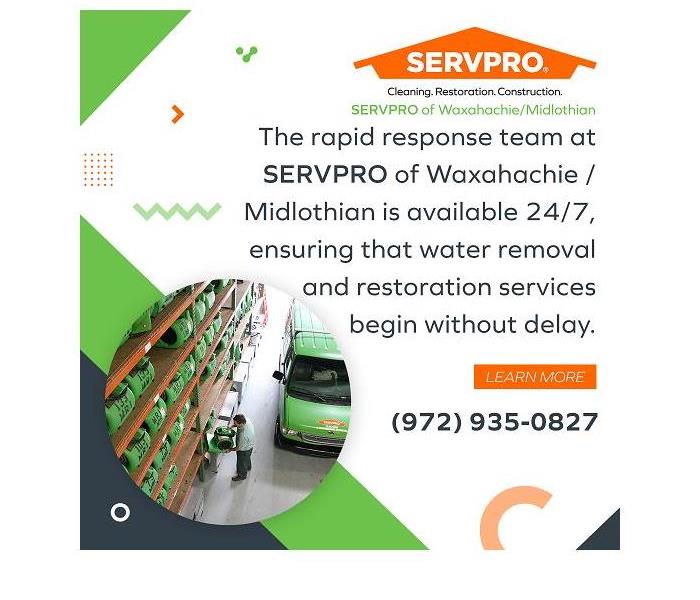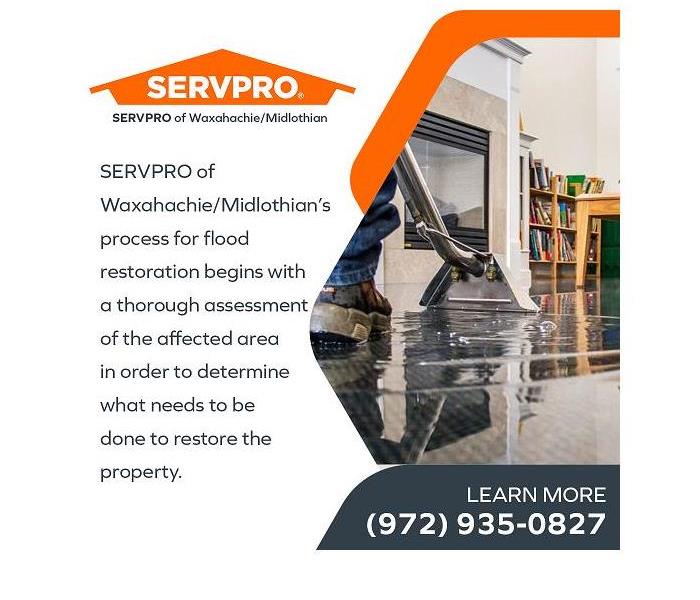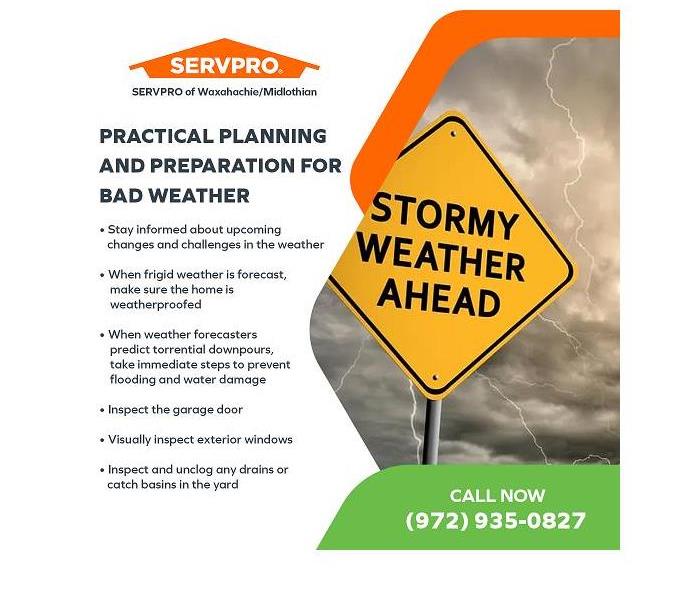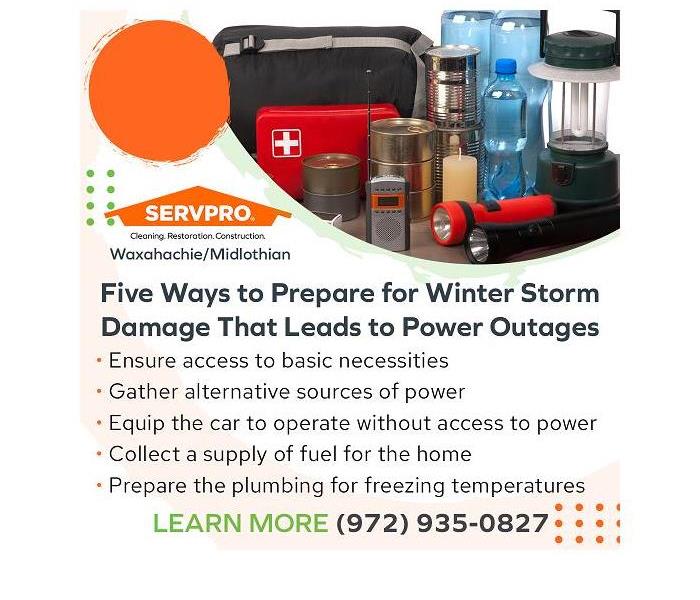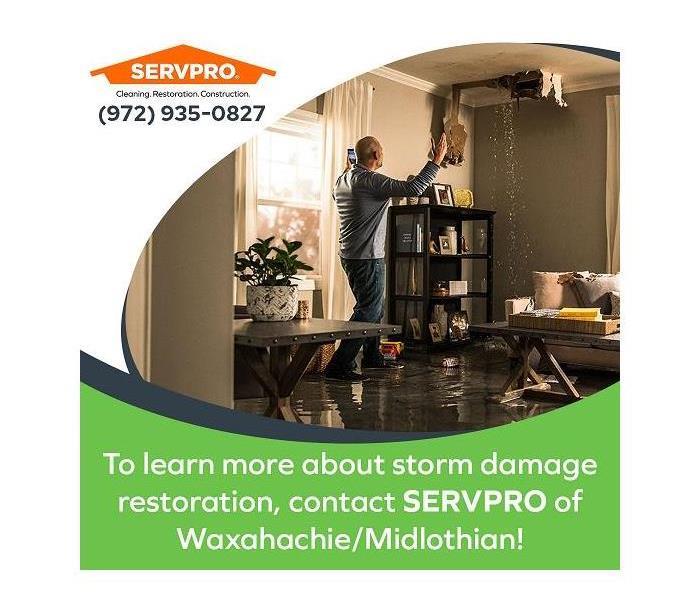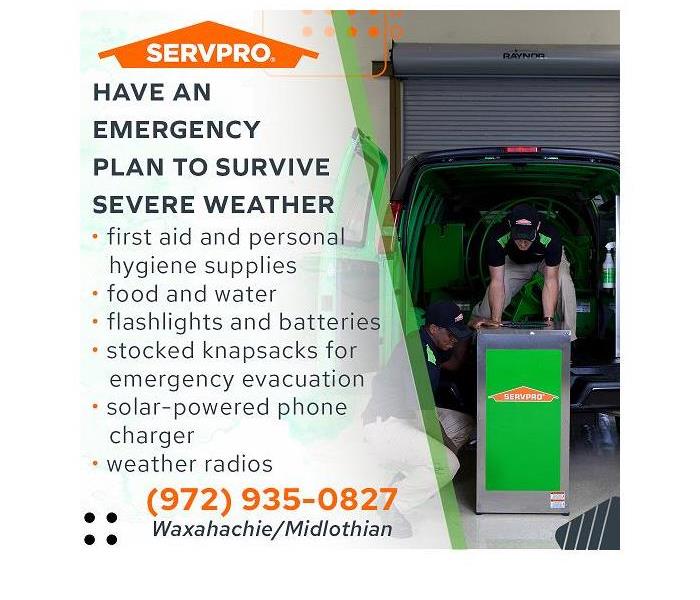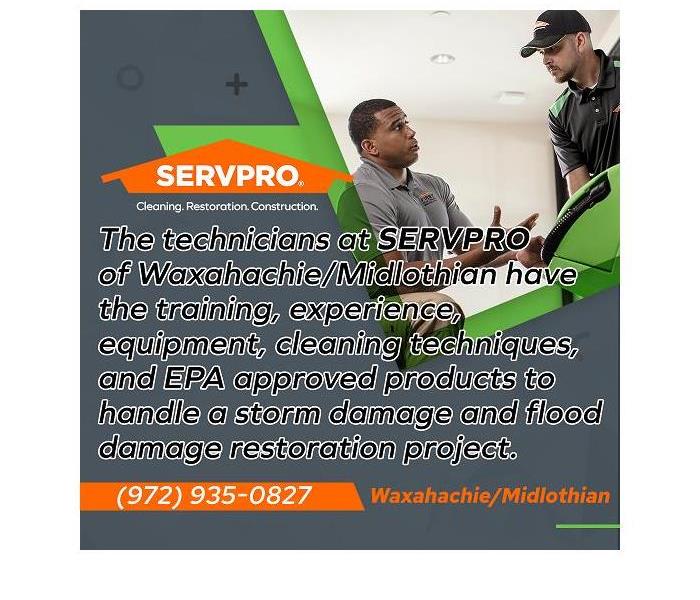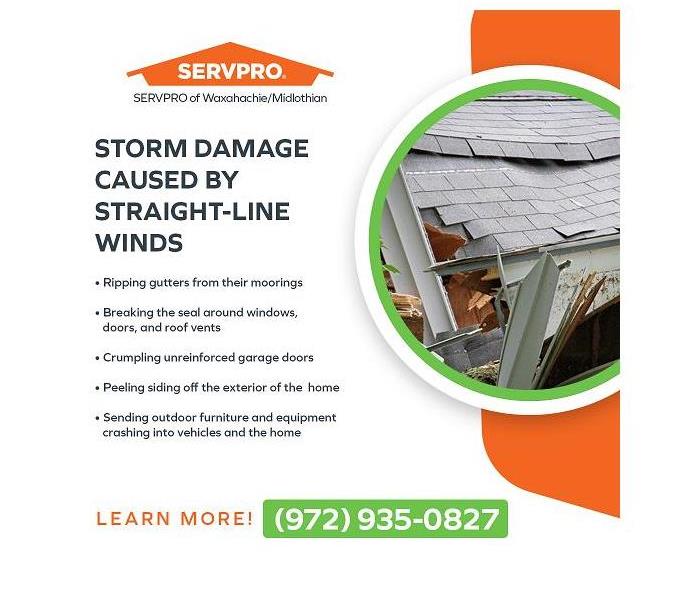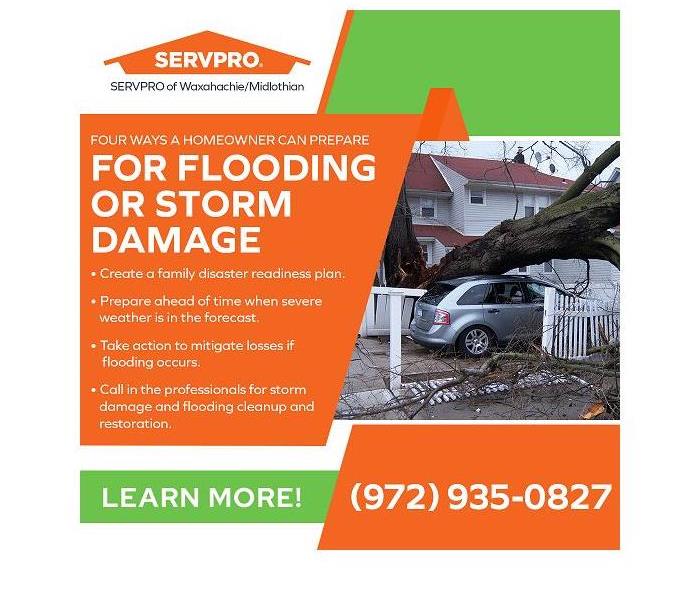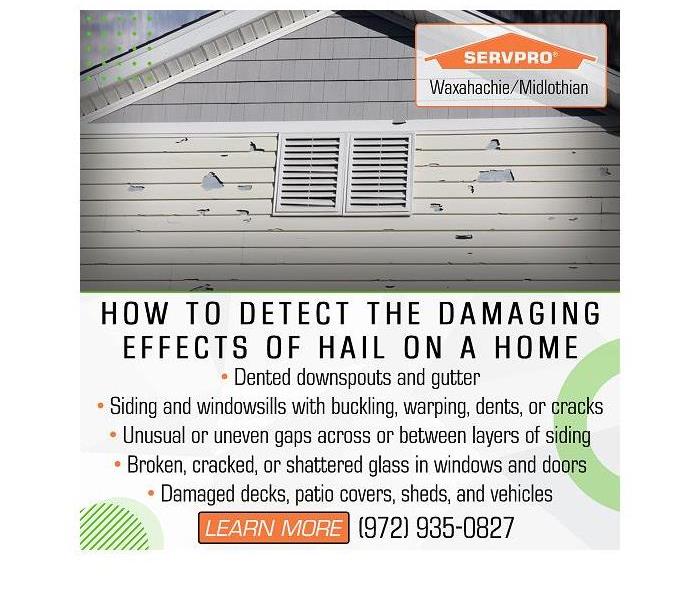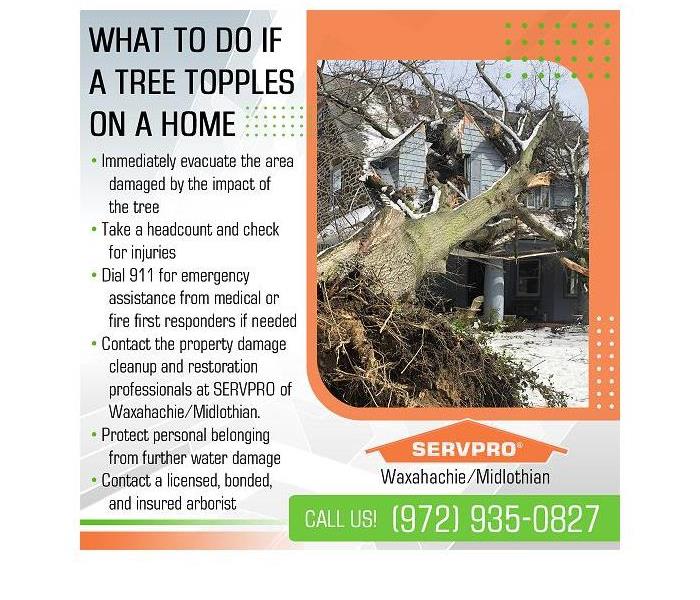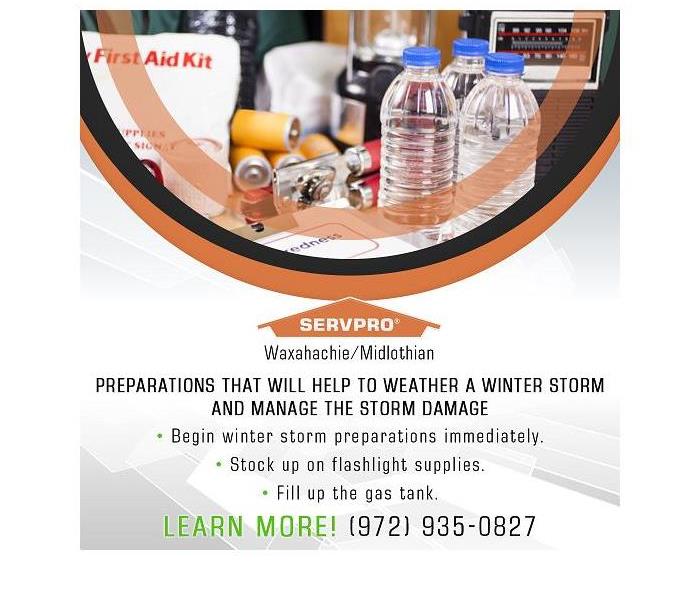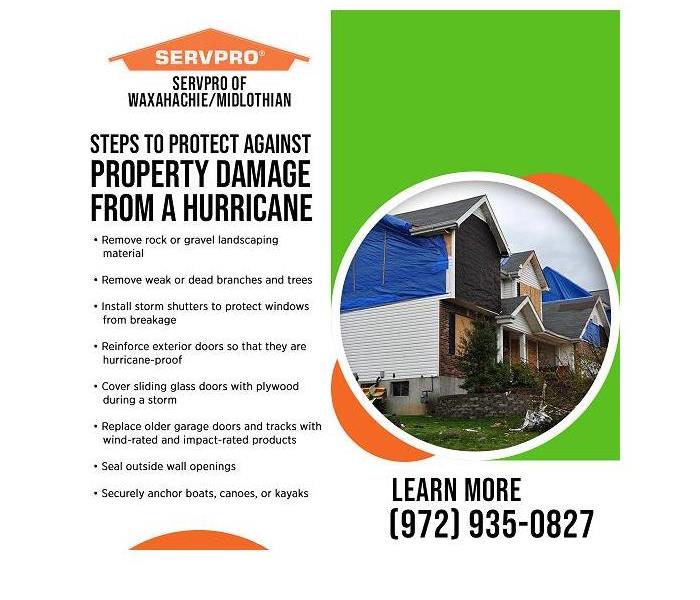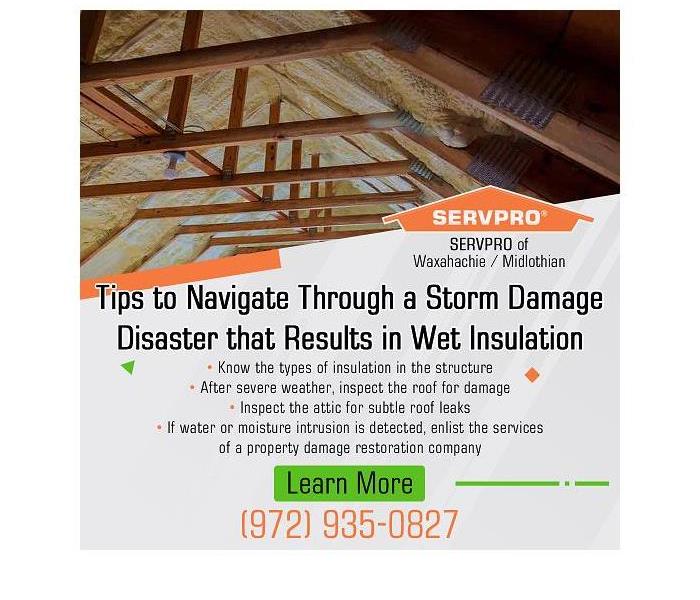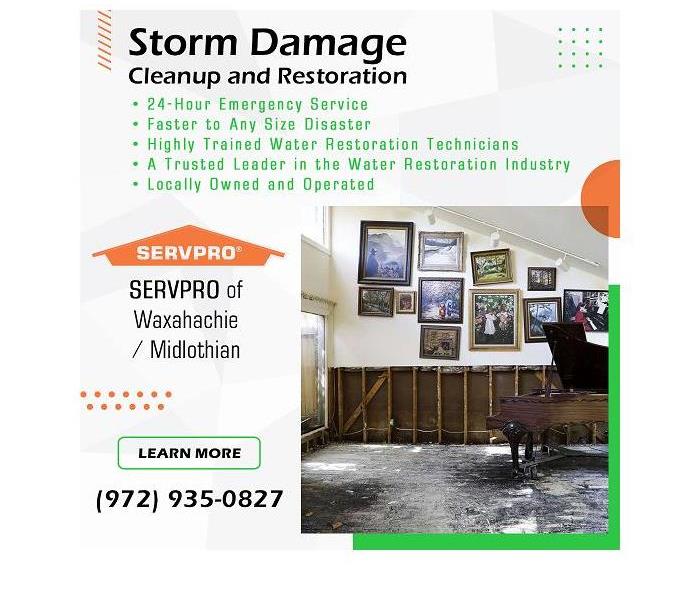Recent Storm Damage Posts
Restoring Your Home After a Storm: SERVPRO of Waxahachie Makes It "Like it never even happened"
5/31/2024 (Permalink)
 Storm season is upon us! When storms strike, water damage can cause serious problems for your home or business so call us for immediate assistance!
Storm season is upon us! When storms strike, water damage can cause serious problems for your home or business so call us for immediate assistance!
When a storm strikes, the aftermath can be devastating. From heavy rain and wind to flooding and hail, the damage to your home can be extensive and overwhelming. At SERVPRO of Waxahachie, we understand the urgency and stress that come with storm damage. Our team of highly trained professionals is here to help you restore your property and make it "Like it never even happened."
Comprehensive Storm Damage Restoration Services
At SERVPRO of Waxahachie, we offer a full range of storm damage restoration services to address every aspect of the damage. Our services include:
- Water Removal and Drying: Using advanced equipment, we quickly remove water and dry affected areas to prevent mold and further damage.
- Roof Tarping and Board-Up: We provide emergency roof tarping and board-up services to protect your property from additional harm.
- Debris Removal and Cleanup: Our team will remove debris and perform a thorough cleanup to restore your home to its pre-storm condition.
- Mold Remediation: If mold has developed due to storm-related moisture, we offer comprehensive mold remediation services to ensure your home is safe and healthy.
Why Choose SERVPRO of Waxahachie?
Choosing SERVPRO of Waxahachie means choosing a team dedicated to restoring your home with the highest level of care and expertise. Here’s why we stand out:
- 24/7 Emergency Service: Storms don’t wait for business hours, and neither do we. Our team is available 24/7 to respond to your emergency needs.
- Quick Response Time: We understand that time is of the essence. Our prompt response minimizes damage and reduces the cost of repairs.
- Highly Trained Specialists: Our technicians are IICRC-certified and trained in the latest restoration techniques and technologies.
- Locally Owned and Operated: As a local business, we are invested in our community and committed to providing the best service possible to our neighbors.
Our Proven Process
Our storm damage restoration process is designed to provide you with peace of mind and ensure a smooth and efficient recovery:
- Assessment and Inspection: We conduct a thorough assessment of the damage and develop a customized restoration plan.
- Water Removal and Drying: Using state-of-the-art equipment, we extract water and thoroughly dry the affected areas.
- Cleaning and Sanitizing: We clean and sanitize all restorable items and structures damaged by the storm.
- Restoration: We restore your home to its pre-storm condition, whether that involves minor repairs or major reconstruction.
Customer Testimonials
Don’t just take our word for it. Hear what our satisfied customers have to say:
"SERVPRO of Waxahachie was a lifesaver after the recent storm. Their quick response and professional service made all the difference. They truly made it like the storm never happened!" – Sarah M.
"I was overwhelmed by the storm damage, but the SERVPRO team was amazing. They handled everything from start to finish, and my home looks even better than before." – John D.
Contact Us Today
If your home has been affected by storm damage, don’t wait. Contact SERVPRO of Waxahachie today and let us make it "Like it never even happened." Call us at (972) 935-0827 or visit our website to schedule a consultation.
SERVPRO Waxahachie/Midlothian: The savior to count on for flood restoration in Oak Leaf
6/13/2023 (Permalink)
In the face of devastating floods impacting your Oak Leaf home, knowing when to engage professional flood restoration services becomes paramount. SERVPRO Waxahachie/Midlothian acknowledges the complexities and challenges posed by flood damage and stands ready to provide the necessary expertise and support for a swift and effective restoration of your property.
The impact of floods on your home
The consequences can be devastating when a flood strikes your home in Oak Leaf. Understanding the profound impact of floods on your property is crucial to recognize the importance of prompt action and professional flood restoration services. Here are some of the key ways in which floods can affect your home:
Structural damage
Floods can inflict substantial structural damage on your Oak Leaf home, posing a threat to its stability and safety. The force and weight of floodwaters can exert immense pressure on the foundation, walls, and supporting structures, leading to cracks, shifting, or even collapse. The relentless flow of water can erode the soil around the foundation, compromising its integrity and increasing the risk of structural failure. Additionally, the impact of debris carried by the floodwaters can cause further damage, such as punctured walls, broken windows, and damaged roofing materials.
Water saturation
When floodwaters enter your property, they infiltrate walls, floors, and furniture, saturating them with moisture. This prolonged exposure to water can lead to warping, swelling, and deterioration of materials over time. Drywall may become soft and crumble, flooring materials may warp and become uneven, and wooden structures can weaken and rot. Water saturation compromises the structural integrity of your home and creates an environment conducive to mold and mildew growth. It is essential to promptly address the water saturation issue to prevent further damage and restore your home to its pre-flood state.
Mold growth
Excessive moisture and high humidity levels created by floods create the perfect breeding ground for mold and mildew. Mold spores can quickly multiply and spread throughout your property, compromising indoor air quality and causing potential health hazards. The presence of mold not only damages surfaces such as walls, ceilings, and flooring, but it can also result in musty odors and trigger allergies or respiratory issues in occupants. Effective remediation and thorough cleaning are essential to prevent mold growth and ensure a safe and healthy living environment. Promptly addressing the water damage caused by floods can minimize the risk of mold infestation and preserve the well-being of your home and its occupants.
Electrical hazards
Floodwaters can infiltrate electrical systems, appliances, and wiring, leading to potentially dangerous situations. Water and electricity are a hazardous combination, and the presence of water increases the likelihood of short circuits, power outages, and electrical fires. Damage to electrical components can disrupt essential functions in your home and pose a severe safety risk to you and your family. It is crucial to have a professional assess the electrical systems and make necessary repairs or replacements to restore the functionality and safety of your home. Taking prompt action to address electrical hazards after a flood is essential to protect your property and prevent potential accidents or emergencies.
Contamination and health risks
Floodwaters often carry a range of contaminants, including sewage, chemicals, and bacteria. When these contaminants enter your home during a flood, they can pose significant health hazards to you and your family. Exposure to contaminated floodwaters can lead to illnesses and infections ranging from gastrointestinal issues to respiratory problems. It is crucial to address contamination through thorough cleaning, sanitization, and disinfection processes to ensure a safe and healthy living environment. Professional restoration services can help eliminate contaminants, minimize health risks, and restore the cleanliness and safety of your home after a flood.
Signs your house may also contain traces of previous floods
Discovering whether your house has experienced previous floods is essential for assessing potential risks, understanding the history of the property, and taking necessary precautions. Even if the previous floods were minor or occurred before you owned the house, there might still be signs indicating their occurrence. Here are four telltale signs your house is still impacted by previous floods:
Water stains and discoloration
One of the most prominent signs that your house may have experienced previous floods is the presence of water stains and discoloration on various surfaces. These stains can manifest as discolored patches on walls, ceilings, or floors, typically appearing as shades of brown, yellow, or gray. The irregular shape of these stains often sets them apart from typical wear and tear or cosmetic issues.
Water stains are particularly common near the baseboards, where water may have seeped in during a flood. They can also extend vertically from the floor upwards, indicating the height to which the water reaches during the flooding event. In some cases, you might even notice visible water lines, resembling a tide mark, along the walls or around windows.
Discoloration can also be visible on wallpaper or painted surfaces. Wallpaper may show signs of peeling, bubbling, or discoloration, while paint may appear cracked, blistered, or have a powdery texture. These visual cues serve as telltale signs of previous water intrusion and can provide valuable insight into the history of flooding in your home.
If you come across water stains or discoloration, it is crucial to investigate further. These marks suggest that water has infiltrated your home, potentially causing damage to underlying structures or leading to mold growth. Seeking professional assistance to assess the extent of the damage and develop an appropriate restoration plan is vital to ensuring your home's long-term stability and safety.
Musty odors and mold growth
One of the most concerning consequences of previous floods in your home is the potential for musty odors and mold growth. Even if visible signs of mold are not apparent, persistent musty odors can strongly indicate past water intrusion and subsequent mold development. Floodwaters introduce excessive moisture into your home, creating a favorable environment for mold and mildew to thrive. These microorganisms can quickly colonize hidden areas, such as behind walls, under flooring, or within ceiling cavities, where moisture may have accumulated during the flood. As mold grows, it releases volatile organic compounds (VOCs) that emit a distinct musty smell.
If you detect persistent musty odors in your home, it is crucial to address them promptly. Ignoring these odors can lead to further mold growth, compromising indoor air quality and potentially causing health issues for you and your family. Mold exposure can trigger allergies, respiratory problems, and even more severe health conditions in susceptible individuals.
Warped or buckled flooring
One of the noticeable signs that your house may have experienced previous floods is the presence of warped or buckled flooring. Floodwaters can cause significant damage to various types of flooring materials, leading to visible irregularities and compromised structural integrity. When water infiltrates your home during a flood, it can saturate the flooring materials, such as hardwood, laminate, or vinyl. As a result, these materials absorb moisture, causing them to expand and contract. Over time, this repeated swelling and shrinking can lead to warping or buckling of the flooring.
Hardwood floors, for instance, may exhibit cupping, where the boards become concave, or crowning, where they become convex. This irregularity in the surface can be both visually unappealing and a potential safety hazard. Laminate or vinyl flooring may display signs of peeling, separation, or buckling, making them uneven and potentially causing tripping hazards. It is important to address warped or buckled flooring promptly. Not only can it compromise the aesthetic appeal of your home, but it can also indicate potential structural issues. Uneven flooring may affect the stability and balance of furniture and increase the risk of accidents or falls.
Water marks on exterior walls or foundation
Examining the exterior can provide valuable insights when evaluating whether your house has experienced previous floods. Watermarks or discoloration on the exterior walls or foundation can be telltale signs of past water intrusion and flooding.
Inspect the exterior walls of your house, paying close attention to areas near the ground level. Look for visible water stains, which may appear as distinct lines or discoloration. These marks indicate the water level reached during a flood event and provide a visual record of past water damage. Additionally, examine the foundation of your home for signs of water infiltration. Water marks, visible discoloration, or even erosion around the foundation can suggest previous flooding. Cracks in the foundation may also be indicative of water damage caused by the pressure exerted by floodwaters.
Identifying water marks on the exterior walls or foundation is essential, as it can help you assess your home's vulnerability to future flooding events. It provides valuable information for implementing the necessary preventive measures to minimize the risks associated with flooding. Waterproofing measures, such as sealing cracks and applying water-resistant coatings, can help protect your home from future water intrusion and potential damage.
How Waxahachie/Midlothian's flood restoration service works
Rapid assessment and emergency response
When your Oak Leaf home is affected by a flood, the first crucial step in Waxahachie/Midlothian's flood restoration service is a rapid assessment and emergency response. As soon as you contact SERVPRO of Waxahachie/Midlothian, a team of highly trained professionals is swiftly dispatched to your property. They arrive equipped with the necessary expertise and specialized equipment to evaluate the extent of the flood damage.
Upon reaching your residence, the team conducts a thorough assessment, meticulously examining the affected areas and identifying potential hazards or safety concerns. This assessment serves as the foundation for devising a customized restoration plan tailored to your home's unique needs. By promptly assessing the situation, SERVPRO Waxahachie/Midlothian ensures that no time is wasted in initiating the restoration process.
During the emergency response phase, the team immediately mitigates further damage. They may implement temporary measures such as boarding broken windows, tarping roofs, or setting up containment barriers to prevent additional water intrusion. These actions help secure your property and protect it from potential threats, ensuring your home's and its occupants' safety.
Water extraction and drying
After the rapid assessment and emergency response, SERVPRO Waxahachie/Midlothian's flood restoration service in OakLeaf moves forward with the critical water extraction and drying step. This phase focuses on efficiently removing standing water from your home and thoroughly drying the affected areas to prevent further damage and inhibit the growth of mold and mildew. High-powered pumps and industrial-grade wet/dry vacuums extract water swiftly and effectively, ensuring no moisture is left behind. Removing water promptly mitigates the risk of structural damage, the deterioration of building materials, and the potential for secondary issues such as mold growth.
Once the water extraction is complete, the team focuses on thorough drying. They employ professional-grade dehumidifiers and air movers strategically placed throughout your home to create an optimal drying environment. These powerful machines work in tandem to extract moisture from the air and surfaces, accelerating the drying process. By carefully monitoring the humidity levels and utilizing advanced moisture detection tools, the technicians ensure that every affected area is thoroughly dried to prevent further damage and minimize the risk of mold or mildew development.
The water extraction and drying phases are crucial to restoring your Oak Leaf home after a flood. By swiftly removing water and implementing comprehensive drying techniques, they safeguard your property from long-term damage and create optimal conditions for subsequent cleaning and restoration.
Thorough cleaning and sanitization
Following the water extraction and drying process, SERVPRO Waxahachie/Midlothian emphasizes thorough cleaning and sanitization as a vital step in flood restoration. This phase aims to eliminate contaminants, odors, and potential pathogens that the floodwaters may have introduced, ensuring a safe and healthy living environment for you and your family.
Using specialized cleaning agents and advanced techniques, the highly trained SERVPRO Waxahachie/Midlothian technicians meticulously clean every affected surface, including walls, floors, furniture, and personal belongings. They pay particular attention to areas prone to mold growth, ensuring that any existing or potential mold spores are effectively eradicated. This meticulous approach minimizes the risk of future mold infestations and promotes better indoor air quality.
Moreover, SERVPRO Waxahachie/Midlothian incorporates sanitization methods that further enhance the cleanliness of your home. They utilize professional-grade disinfectants proven to eliminate many bacteria, viruses, and other harmful microorganisms. This thorough sanitization process provides extra protection and peace of mind for you and your loved ones.
By prioritizing thorough cleaning and sanitization, SERVPRO Waxahachie/Midlothian ensures that your Oak Leaf home is visually restored but also safe and healthy.
Restoration and reconstruction
After water extraction, drying, and thorough cleaning, SERVPRO Waxahachie/Midlothian moves on to the essential phase of restoration and reconstruction. This stage focuses on repairing and rebuilding the areas of your Oak Leaf home damaged by the flood, aiming to restore your property to its pre-flood condition. The skilled team at SERVPRO Waxahachie/Midlothian works closely with you, collaborating to identify the extent of the damage and develop a comprehensive plan to restore your home to its original state. Whether repairing damaged walls, replacing flooring, or reconstructing entire rooms, they employ their expertise to execute the necessary repairs with precision and care.
With access to a vast network of trusted contractors and suppliers, SERVPRO Waxahachie/Midlothian ensures that only the highest quality materials and craftsmanship are employed during the restoration and reconstruction. They strive to seamlessly blend the repaired or reconstructed areas with the existing structure, ensuring a cohesive and aesthetically pleasing result.
Throughout the restoration and reconstruction phase, open communication and transparency are paramount. The SERVPRO Waxahachie/Midlothian team keeps you informed about the project's progress, addressing any concerns or questions you may have along the way.
Why you should consider SERVPRO of Waxahachie/Midlothian’s flood restoration services
Immediate response
When it comes to flood damage, time is of the essence, and SERVPRO of Waxahachie/Midlothian understands the importance of a prompt response. They prioritize your call and ensure that help is on the way as quickly as possible. With their 24/7 availability, their dedicated team is ready to spring into action, regardless of the time or day. Upon receiving your call, SERVPRO of Waxahachie/Midlothian promptly dispatches a trained and experienced crew to your location. Their swift response ensures that crucial steps can be taken immediately to mitigate further damage and start the restoration process without delay. By arriving on the scene quickly, they can assess the situation, develop an effective plan, and implement the necessary measures to restore your home. This immediate response is crucial for several reasons. Firstly, it helps prevent additional water damage from occurring.
Floodwaters can seep into various materials, causing further deterioration, mold growth, and structural issues if left unaddressed. By arriving promptly, SERVPRO of Waxahachie/Midlothian can assess the extent of the damage and take immediate steps to mitigate the risks. Secondly, their prompt action can help salvage valuable possessions and personal belongings. Time is critical in preserving items affected by floodwaters, such as furniture, electronics, documents, and sentimental items. With their quick response, SERVPRO of Waxahachie/Midlothian can prioritize the salvageable items and begin the necessary steps for their restoration.
Lastly, their immediate response demonstrates their commitment to customer satisfaction. Dealing with the aftermath of a flood can be overwhelming, and having a responsive team by your side provides reassurance and peace of mind. SERVPRO of Waxahachie/Midlothian's swift action shows that they prioritize your needs and are dedicated to restoring your home as quickly as possible.
Streamlined communication
Effective communication is vital during a flood restoration process, and SERVPRO of Waxahachie/Midlothian excels in this aspect, ensuring a seamless and hassle-free experience for their customers. Their streamlined communication begins with the initial assessment and consultation. A representative from SERVPRO of Waxahachie/Midlothian will visit your property to assess the damage and discuss the restoration plan. During this phase, they take the time to listen to your concerns, answer your questions, and address any specific requirements you may have. Once the restoration work begins, they maintain open lines of communication to provide regular updates on the progress and any changes to the plan. They keep you informed about the steps being taken, the timeline, and any adjustments that may be required based on unforeseen circumstances.
This transparent communication helps you stay informed, make informed decisions, and feel confident in restoration. In addition to proactive updates, SERVPRO of Waxahachie/Midlothian encourages customers to reach out with any questions or concerns. They are responsive to inquiries and readily available to address any issues that arise during the restoration process. Their team takes the time to listen attentively and provide clear explanations, ensuring that you are comfortable and informed every step of the way. Maintaining a high communication standard, SERVPRO of Waxahachie/Midlothian ensures you actively participate in restoration. Their friendly and professional team is committed to providing clear, concise, and timely information, making the entire experience as smooth and stress-free as possible.
Efficient workflows
SERVPRO of Waxahachie/Midlothian has developed efficient workflows that enable them to handle flood restoration projects quickly and precisely. Their well-defined processes and skilled team contribute to their reputation as a service provider that efficiently completes the job.
Upon arrival at your property, SERVPRO of Waxahachie/Midlothian's experienced technicians promptly assess the extent of the flood damage. This initial assessment allows them to develop a customized plan tailored to your needs. By focusing on efficiency, SERVPRO of Waxahachie/Midlothian ensures the restoration process is completed within a reasonable timeframe, minimizing disruption to your daily life. Their commitment to efficient workflows means you can rely on them to restore your property promptly, allowing you to return to a safe and habitable environment as quickly as possible.
Comprehensive services
By focusing on efficiency, SERVPRO of Waxahachie/Midlothian ensures the restoration process is completed within a reasonable timeframe, minimizing disruption to your daily life. Their commitment to efficient workflows means you can rely on them to restore your property promptly, allowing you to return to a safe and habitable environment as quickly as possible. Whether it's water extraction, drying, mold remediation, or structural repairs, SERVPRO of Waxahachie/Midlothian has the expertise and resources to handle every aspect of the restoration process.
One of the key advantages of their comprehensive services is that they can address visible and hidden damage. Floodwaters can seep into walls, floors, and other hidden areas, leading to long-term issues such as mold growth and structural deterioration. SERVPRO of Waxahachie/Midlothian's experienced team utilizes advanced techniques and equipment to detect and mitigate hidden damage, ensuring your property is thoroughly restored and protected from future complications. Moreover, their comprehensive services extend beyond restoration to include cleaning and sanitization. Floodwaters can introduce contaminants and pathogens into your home, posing health risks to you and your family.
SERVPRO of Waxahachie/Midlothian follows industry-leading protocols to clean and sanitize affected areas, eliminating harmful substances and ensuring a safe living environment. Their attention to detail and commitment to thorough cleaning leaves no room for compromise when it comes to your health and well-being.
By offering a wide range of services, SERVPRO of Waxahachie/Midlothian eliminates the need for you to coordinate multiple contractors. Their comprehensive approach saves you time, effort, and potential complications that may arise from working with different service providers. With their expertise and comprehensive services, you can trust that every aspect of the flood restoration process is handled efficiently and professionally.
Local expertise and resources
SERVPRO of Waxahachie/Midlothian brings a unique advantage to flood restoration in Oak Leaf with its local expertise and abundant resources. Being a part of the community, they understand the specific challenges and requirements of the area, allowing them to deliver tailored solutions and exceptional service.
As a locally owned and operated business, SERVPRO of Waxahachie/Midlothian has deep roots in the Oak Leaf community. They are familiar with the local climate, common sources of flooding, and the unique characteristics of properties in the area. This local knowledge gives them an edge in understanding homeowners' specific needs and challenges when dealing with flood damage.
Furthermore, their local expertise enables them to respond quickly to emergencies. Flooding can cause significant damage if not addressed promptly, and SERVPRO of Waxahachie/Midlothian's local presence allows them to arrive at your property swiftly. They understand the urgency of the situation and strive to initiate the restoration process as soon as possible, mitigating further damage and reducing the overall restoration time.
In addition to their local knowledge, SERVPRO of Waxahachie/Midlothian has access to abundant resources. As part of a national network of SERVPRO franchises, they have the support and backing of a company with over 50 years of experience in the restoration industry. This network provides them access to advanced equipment, cutting-edge technologies, and industry-leading training.
Having a wide array of resources at their disposal, SERVPRO of Waxahachie/Midlothian can efficiently tackle flood restoration projects of any size or complexity. Their skilled technicians are trained in the latest techniques and methodologies, ensuring they deliver high-quality results every time. By combining their local expertise with the resources of a reputable national company, they provide a winning combination that sets them apart from other service providers. Moreover, SERVPRO of Waxahachie/Midlothian's local presence and strong community ties mean that they prioritize customer satisfaction. They are committed to building long-term relationships with their clients and strive to exceed expectations with every project. Their dedication to delivering top-notch service, backed by their local expertise and access to abundant resources, makes them a trusted partner for flood restoration in Oak Leaf.
SERVPRO Waxahachie/Midlothian: The knight in shining armor
SERVPRO of Waxahachie/Midlothian's local expertise and abundant resources make them a standout choice for flood restoration services in Oak Leaf. Their understanding of the local area, quick response times, and access to advanced equipment ensure efficient and effective restoration. With their strong community ties and commitment to customer satisfaction, they are a reliable and trusted partner you can count on in times of flood-related emergencies. SERVPRO of Waxahachie/Midlothian stands out as the fastest and easiest flood restoration service in Oak Leaf, TX, due to their immediate response, streamlined communication, efficient workflows, comprehensive services, and local expertise. When faced with a flood emergency, you can trust them to provide a hassle-free and efficient restoration experience, getting your home back to its pre-flood condition in no time. Contact them to refurbish your home promptly.
SERVPRO of Waxahachie/Midlothian provides comprehensive flood restoration services to businesses in Ovilla, TX
5/7/2023 (Permalink)
Blog Summary: SERVPRO® of Waxahachie/Midlothian is assisting local businesses in Ovilla, TX, to recover from storm-related flooding. SERVPRO is a reputable and skilled firm with the resources and expertise to perform complete flood restoration services such as water extraction, dehumidification, structural drying, and mold removal.
Flood Damage and local businesses in Ovilla, TX
The city of Ovilla, TX, has recently been affected by a severe storm, causing severe flooding and damage to local businesses and properties. The storm brought excessive amounts of rainfall, which caused flooding in the area and damaged many properties and businesses in Ovilla, TX. SERVPRO of Waxahachie/Midlothian is a local business with a national network specializing in flood damage restoration and offers services to help local businesses recover from flooding.
The Importance of Hiring SERVPRO of Waxahachie/Midlothian’s flood restoration services
Recovering from a flood is a difficult and time-consuming process, and it is important to hire a professional flood restoration company to help with the process. SERVPRO of Waxahachie/Midlothian is a local business specializing in flood damage restoration and can help local businesses in Ovilla, TX recover from the flooding. SERVPRO of Waxahachie/Midlothian is a trusted and experienced company with the necessary resources to provide comprehensive flood restoration services.
The SERVPRO of Waxahachie/Midlothian’s restoration process
SERVPRO of Waxahachie/Midlothian’s process for flood restoration begins with a thorough assessment of the affected area to determine what needs to be done to restore the property. The assessment will include a detailed inspection of the affected area, including walls, floors, furniture, and other items that may have been damaged by the flooding. The SERVPRO team will then use professional-grade equipment and techniques to remove the water and restore the affected areas.
Types of services offered by SERVPRO of Waxahachie/Midlothian for flood restoration in Ovilla, TX
SERVPRO of Waxahachie/Midlothian offers various services for flood restoration, including water extraction, dehumidification, structural drying, and mold remediation. SERVPRO of Waxahachie/Midlothian also provides services for damage assessment, such as moisture mapping to identify areas of moisture that may need to be addressed.
Why should property owners in Ovilla, TX choose SERVPRO for flood restoration?
SERVPRO of Waxahachie/Midlothian is a trusted and experienced company with the necessary resources to provide comprehensive flood restoration services in Ovilla, TX. SERVPRO of Waxahachie/Midlothian has a team of certified and trained technicians who use professional-grade equipment and techniques to restore properties after flooding. The company also offers 24/7 emergency services for flood restoration in Ovilla, TX, so property owners can be assured that their restoration needs will be taken care of quickly and efficiently.
The Benefits of Choosing SERVPRO for Flood Restoration in Ovilla, TX.
The SERVPRO team has the experience and resources to provide comprehensive flood restoration services. By choosing SERVPRO of Waxahachie/Midlothian for flood restoration in Ovilla, TX, property owners can be assured that their restoration needs will be met quickly and efficiently. The company’s certified and trained technicians use professional-grade equipment and techniques to restore properties after flooding, and they are available 24/7 in case of emergencies. Additionally, the company offers a range of services, such as water extraction, dehumidification, structural drying, and mold remediation, to help property owners restore their properties after flooding.
SERVPRO of Waxahachie/Midlothian Assists With Flood Restoration Services for Disaster Resiliency Planning
4/11/2023 (Permalink)
Blog Summary: SERVPRO of Waxahachie/Midlothian provides education and training to the community on disaster preparedness, including seminars and workshops. The company is committed to helping the community of Waxahachie become more resilient to future disasters.
Waxahachie, Texas – SERVPRO of Waxahachie/Midlothian has been at the forefront of providing quality flood restoration services in Waxahachie and the surrounding communities. The company is committed to assisting the community in disaster resiliency planning and is helping to make the area more resilient to future disasters.
What is disaster resiliency planning?
Formulating a resiliency strategy is a step-by-step plan to reduce the effects of possible disasters. This includes recognizing the potential harm caused by various catastrophes and taking measures to lessen their impact. Furthermore, emergency preparedness planning incorporates teaching the public how to be ready for upcoming catastrophes and supplying assets that can aid them in doing so.
Disaster resiliency planning with SERVPRO of Waxahachie/Midlothian as your partner
SERVPRO of Waxahachie/Midlothian stands out among the competition by formulating plans to lessen the harm of potential catastrophes in Waxahachie, emphasizing its significance. The company is in close collaboration with the Waxahachie Emergency Management Office to make sure that the citizens are completely ready for any possible crisis.
The company provides multiple assistance to facilitate disaster preparedness planning for the area. These aids involve flood restoration, structural repair, and mold remediation. The services provided by SERVPRO of Waxahachie/Midlothian are intended to minimize the effects of floods and other calamities. In addition, they cooperate with local insurance agencies to guarantee that citizens are appropriately protected in the event of an emergency.
SERVPRO of Waxahachie/Midlothian offers education and training to the community regarding disaster preparedness. They equip locals with the necessary tools and resources they need to plan for future occurrences.
SERVPRO likewise provides a complimentary Emergency Ready Program for residences. This program assists to reduce the turmoil triggered by a calamity and provides a clear, fast path to recovery. This plan identifies the places with shut-off valves, areas of the highest importance, and essential contact details, then stores it all in one place for easy access if something catastrophic happens. Additionally, it simplifies the insurance claims process and helps homeowners find qualified services for property damage cleanup and restoration. By having an emergency strategy in place, homeowners will just need to dial one number to get the necessary help when a disaster occurs.
By having SERVPRO of Waxahachie/Midlothian as your partner, you can confidently feel secure knowing that your area is equipped to face any potential disaster.
Flood restoration services from SERVPRO of Waxahachie/Midlothian
For two decades, the people of Waxahachie and its surrounding communities have benefited from the flood restoration work given by SERVPRO of Waxahachie/Midlothian. This company has gained so many acknowledgments for its quick, useful, and dependable services in returning properties to their pre-damage condition.
The staff at SERVPRO of Waxahachie/Midlothian receive the HeroReady Training Program to stay up-to-date with the most advanced methods and safety protocols for restoring properties. They have training sessions at SERVPRO's main training center and also continual certification from IICRC. This guarantees that the team has the necessary skills and qualifications to help their customers.
The SERVPRO Disaster Recovery Team is constantly prepared to lend a hand in the event of an emergency. Their expertise includes responding to catastrophes such as tornadoes, hurricanes, snowstorms, and floods. An extensive system of prearranged storm crews waits eagerly, able to act quickly and with efficacy in the event of any devastating situation in the region. With SERVPRO's Disaster Recovery Team at your disposal, you can be sure that your community will be looked after if disaster strikes. Their services are operational 24/7, 365 days of a year.
For more information about SERVPRO of Waxahachie/Midlothian and its flood restoration services in and around Ovilla, TX, please visit https://www.SERVPROwaxahachiemidlothian.com/, call them at (972) 935-0827 or email them at acarey@SERVPRO10932.com.
Prevention Tips to Protect Midlothian, TX, Homes from Water and Flood Damage Caused by Winter Storms
2/8/2023 (Permalink)
Blog Summary: SERVPRO of Waxahachie/Midlothian highlights practical ways Midlothian, TX, residents can prepare for winter weather and avoid water and flood damage.
SERVPRO® of Waxahachie/Midlothian provides water damage and flood restoration services in all seasons and for any situation. Water damage and flood damage may be caused by severe thunderstorms and high winds. The culprit may be frozen pipes from frigid temperatures or flooding from torrential downpours, such as the rainfall that occurred in February 2018.
The Dallas-Fort Worth area is recognized for its tolerably mild winters and sometimes intolerably hot summers. However, frigid temperatures and frozen precipitation in the form of sleet, snow, and freezing rain can bring life to a standstill for days, as was the case in February of 2021. The wind and solar power grid completely collapsed, leaving hundreds of thousands in their cold, dark homes. Nearly 300 people lost their lives.
Many lessons were learned from this weather crisis experience. One of the most important lessons to emerge from this tragic catastrophe is the need for preparation at a level that could sustain a family through an extended period of time with limited or no infrastructure services such as power and water. The failure of the power grid meant no lights, no heat, and no cooking for many families. Many people were without water because their pipes froze and burst. Three of Fort Worth’s water treatment plants went offline due to the widespread power grid collapse. A cascade of catastrophes left the general population of North Texas cold, hungry, in the dark, and in danger for their lives.
Winter weather warnings and advisories
To survive a widespread weather catastrophe, residents need to know how to interpret and respond to the various types of winter weather advisories and warnings issued by the National Weather Service. Residents in the affected areas also need to make preparations for a winter weather worst-case scenario. The vulnerability of the power grid drives home the need to prepare not just for a fifty-year snowstorm but for the collapse of the power grid that could last days and weeks due to weather conditions that may not be all that severe. The key is to be prepared, stay vigilant, and respond correctly to the situation.
- An “advisory” indicates if caution is exercised, these events should not threaten lives.
- A “watch” indicates that hazardous conditions are possible, and residents must stay informed of any changes.
- A “warning” means situations are potentially life-threatening, and residents should take immediate action to ensure their preparedness and survival.
These alerts from the National Weather Service should be taken seriously and acted upon promptly and appropriately. The proper response at the right time will save lives.
Practical planning and preparation for bad weather
Tip: Stay informed about upcoming changes and challenges in the weather. Modern weather forecasting can provide residents with advisories, watches, and warnings so they can be ready when rough weather arrives. Keep two weather radios on hand and loaded with fresh batteries, and keep a supply of batteries dedicated to powering the weather radios.
Tip: When frigid weather is forecast, make sure the home is weatherproofed to prevent water damage. Cover external faucets with insulation, and wrap exposed pipes with insulation. When temperatures plummet, turn on faucets to allow for a steady drip or slow trickle. Open the cabinet doors below the sink to allow the home’s heat to warm the pipes under the sink.
Tip: When weather forecasters predict torrential downpours, as was experienced in 2018, take immediate steps to prevent flooding and water damage. Inspect and clean out gutters. Make sure that downspouts are connected, and extensions direct the water away from the foundation. The grade around the foundation should be 1 inch of slope per foot for at least six to ten feet away from the home. Inspect the sump pump system. Clean out any debris in the sump area. Pour a bucket of water into the sump area to ensure the pump works. Test the backup sump pump as well. Inspect the attic and mark any areas where a leak is suspected. If time permits, have the roof inspected by a licensed roofing contractor. After the wet or snowy weather, reinspect the attic for any evidence of new leaks.
Tip: Inspect the garage door, the first line of defense against flooding in the garage. If needed, replace the weather stripping on the bottom of the door to prevent water from leaking into the garage.
Tip: Visually inspect exterior windows. The windows should be closed. Look for cracked or broken panes that could allow for a water intrusion.
Tip: Inspect and unclog any drains or catch basins in the yard. The fall leaf shed can greatly reduce the flow rate of water into the drain or basin, resulting in a micro flood of catastrophic proportions for that home.
The tips listed above will help prevent water damage and flood damage when temperatures are frigid, and the rain gauge is overflowing from an extended torrential downpour. When a property damage disaster strikes, trust the cleanup and restoration project to the team at SERVPRO of Waxahachie/Midlothian. Since the locally owned company is centrally located in Ellis County, a team of IICRC-certified technicians can arrive on-scene in about thirty minutes, 24/7, 365 days a year, including holidays. The rapid response and quick cleanup and restoration process get life back to normal as soon as possible.
To learn more about flood restoration services, call SERVPRO of Waxahachie/Midlothian at (972) 935-0827 or email at acarey@SERVPRO10932.com.
Caring for pets after storm damage and during the flood damage restoration processes
1/25/2023 (Permalink)
Blog Summary: SERVPRO® of Waxahachie/Midlothian offers homeowners tips on ensuring that pets are cared for in a storm damage disaster or flash flood.
SERVPRO of Waxahachie/Midlothian is committed to helping homeowners recover from storm damage by providing reliable, rapid flood restoration services. Often when a storm or flash flood is the cause of the damage, many homes and businesses are affected. Many of these homes also include furry cats and dogs.
According to census data, residents in the Dallas-Fort Worth area are avid pet lovers. “About half of all households in the Dallas-Fort Worth-Arlington metro area own a pet, according to recently-released data from the U.S. Census. Forty-one percent (41%) have at least one dog, and 17% have at least one cat.”
Americans spend $99 billion on pets and pet products each year. Pets are special and deserve careful attention before, during, and after a storm damage disaster. The family emergency-ready plan should also consider the needs of any family pets. Listed below are some tips to facilitate the creation of this pet emergency preparedness plan.
#1. Take steps to ensure pets are identifiable at all times and in any situation
Pets seem to have a sense of impending danger. During the chaos, the family dog or cat may flee the home in terror. The pet may wander for miles seeking relief from sensory overload and searching for a calm, quiet refuge.
Keep a collar and ID tags on the family dog, cat, and other four-legged pets. When pets and family members become separated, a microchip is a simple, inexpensive means to ensure pets are always identifiable. A collar and identification tag can be lost. A microchip is an onboard form of digital identification that requires only a swipe with a microchip reader to glean the pet’s information (name, owner’s contact information, etc.) embedded on the chip. The pet owner should keep their address, phone number, and other chip information current.
#2. Locate pet-friendly emergency shelters
Before disaster strikes, identify emergency shelters and safe escape routes to these shelters. If homeowners and their family members have pets, search for shelters that accommodate animals. Due to the public health hazards posed by animals, many shelters cannot allow pets. Create a list of kennels or animal shelters that can safely house pets until the danger has passed. Identify hotels that allow pets. If none of these options are available, identify a trusted friend or relative who lives outside the affected area and ask them to take care of the pets during the disaster cleanup and restoration process.
#3. Customize an emergency kit with supplies for each pet
Remember to include the needs of family pets when assembling an emergency supply kit. Designate one of the family members to grab the pet emergency kit and take care of the pets during the disaster. The emergency preparedness kit for the pets should include the following items:
- Food and water for at least several days
- Spare ID tags, leashes, or harnesses
- Pet carriers
- Garbage bags for clean up
- First aid items that are safe for pets, along with any medications
- Vital pet data, such as vaccination records and photographs for identification
- Pet toys
- Kitty litter
#4. Contact the ASPCA to obtain a rescue alert sticker
Attach the rescue alert stickers on or near the front door to inform rescue workers that pets may be inside the home. The pet owner may also want to include other information, such as the number and types of pets, the veterinarian’s contact information, and personal contact information. If threatening weather conditions are approaching, affix the sticker in a highly visible location near the front door. If an evacuation should be necessary, note this information on the sticker when leaving the premises.
Pets are beloved family members and need special attention during any event that disrupts the household's daily routine. Be mindful that pets may not always respond positively to first responders, rescue workers, or cleanup and restoration crews.
When storm or flood damage occurs, contact the team of cleanup and restoration professionals at SERVPRO of Waxahachie/Midlothian. Available 24/7, 365 days a year, including holidays, technicians can be on-scene in about an hour. The rapid response and quick cleanup help prevent advanced secondary damage such as mold infestation.
For more information about flood restoration services in Ovilla, TX, contact SERVPRO of Waxahachie/Midlothian by phone at (972) 935-0827. The office can also be reached by emailing acarey@SERVPRO10932.com.
Five Ways to Prepare for Winter Storm Damage That Leads to Power Outages
11/8/2022 (Permalink)
Blog Summary: SERVPRO® of Waxahachie/Midlothian outlines five ways to prepare for winter storm power outages that could potentially lead to water damage and fire damage.
A winter storm can cause power outages that lead to a myriad of difficulties, including potential fire and water damage. By applying the information in the tips listed below, local homeowners can take steps to prepare before the storm hits so that they put themselves in a better position to recover after the storm passes.
Ensure access to basic necessities
Homes that are not connected to a municipal water supply will not be able to continue to provide water in a power outage. Well pumps do not operate without electricity, so homeowners who use well water will need to have an adequate supply of bottled water on hand. If the forecast gives enough warning, the homeowner can also fill up the washing machine and bathtub to provide extra water sources for bathing, cleaning dishes, or using the toilet.
A stock of nonperishable food items is also essential, especially in the case of an extended outage that leaves a household unable to cook or keep food fresh. Nonperishable foods include:
- nuts
- seeds
- dried fruit
- peanut butter or nut butters
- canned fruits, vegetables, and meat
- chips and crackers
- granola bars and energy bars
- civilian or military surplus ration packs
- freeze-dried meals
Purchase a manual can opener, as well as a backup.
Gather alternative sources of power
Stock up on a wide variety of batteries, from AAA batteries to D batteries to button cell batteries, depending on the needs of the home. Check to see which batteries are used in smoke detectors, medical equipment, flashlights, radios, clocks, and other essential appliances, and purchase plenty of spare batteries in the correct sizes and types. Add extra flashlights and battery-powered radios to the shopping list since these tools are indispensable in the event of power loss.
Equip the car to operate without access to power
When the meteorologist predicts severe winter storms in the forecast, make sure to fill up the gas tank before the power goes out. Gas pumps require electricity to operate, so if the fuel gauge on the car or truck reads at or near empty, it will remain empty until power is restored to the affected area.
Also, keep car chargers on hand to charge phones and devices so that the members of the household can access breaking news, outage updates, and relevant local information. Check to make sure that the car charger is compatible with the devices that will need to be charged.
Collect a supply of fuel for the home
BobVila.com, an online home and garden resource, offers the following recommendation: “Consider how you will stay warm if the power goes out. Even a gas-powered furnace requires electricity to run the fan that sends warm air through the vents. If you have a gas fireplace, consider installing a battery backup for the starter if it doesn’t already have one. If you have a wood stove, stock up on firewood. Do not use a propane heater inside the home unless it is one specifically designed for indoor use; carbon monoxide can build up and create a deadly hazard.”
Some homeowners may have access to a grill that they can use to cook meals. However, grills should never be used inside the home, and neither should candles. When cooking without power, abide by the same fire safety precautions that apply to cooking with power, such as the following safety tips:
- Do not leave the cooking area unattended.
- Remove flammable objects and substances, such as paper towels, dishcloths, wooden utensils, and lighter fluid, from the cooking area.
- Never use water to extinguish a grease fire.
When burning wood to provide heating and cooking, remember that fire damage is a potential risk, so fire safety precautions are essential. Typically, smoke alarms are battery-operated, but if fresh batteries have not been installed recently, replace the batteries to ensure that the unit will be functional in the event of a fire. Also, consider purchasing a fire extinguisher and learning how to use it properly.
Prepare the plumbing for freezing temperatures
An extended power outage is bad enough, but if the home’s water pipes are not well insulated, more trouble could arise when the power comes back on and the temperatures warm up. Frozen pipes can burst and crack, leading to a water damage disaster when the ice melts and water starts to drip or spew from the plumbing. To prepare the water pipes for a winter storm that will cause temperatures to drop to freezing, turn off the main water valve and allow all the faucets to drain until the pipes have been emptied.
Who to call when winter storms lead to property damage
In the event that fire damage or water damage occurs due to the conditions caused by a winter storm power outage, the local community can turn to SERVPRO® of Waxahachie/Midlothian to rapidly provide damage restoration services. The team is available 24/7/365, and the water damage restoration company can draw on the resources of the wider SERVPRO franchise to provide a clean-up and restoration solution for large loss incidents.
For more information about fire and water damage restoration in Red Oak, TX, call the office at (972) 935-0827 or email SERVPRO of Waxahachie/Midlothian at acarey@SERVPRO10932.com.
What Midlothian, TX, Residents Need to Know About Wind Speeds and Storm Damage
10/10/2022 (Permalink)
Blog Summary: SERVPRO of Waxahachie/Midlothian highlights the power of high winds to cause serious storm damage in the Waxahachie and Midlothian, TX communities.
SERVPRO® of Waxahachie/Midlothian highlights the power of high winds to cause serious storm damage in Midlothian, TX, and surrounding communities. Storm damage may be caused by many different factors. Excessive rain is generally thought of as the most common cause of storm damage. The rain may be heavy for a short period of time, and a stalled thunderstorm can spill as much precipitation on an area as a tropical storm or hurricane. Flash flooding can be devastating, especially in areas that are not covered by the FEMA flood insurance program.
Lightning may cause a house fire after a direct strike. One bolt of lightning can take out an entire power grid, putting tens of thousands of people in the dark without water, electricity, or air conditioning.
Wind can also cause severe storm damage. In fact, high winds can damage the roof, gutters, siding, and glass windows and doors of a structure, exposing the home to severe water damage. A brief blast of wind can roll up shingles, underlayment, and OSB board like a piece of carpet. The roof repair might only cost a few thousand dollars, but the water damage could cost tens of thousands of dollars to repair. By fully understanding the power of the wind to cause storm damage, the homeowner will be better able to adequately prepare for, respond to, and recover from a wind-related storm damage disaster.
Wind threat: High to extreme
When the wind threat is high to extreme, windspeeds reach or exceed 90 to 110 mph. At these speeds, the wind poses an extreme danger to life and property. Gusts over 110 mph are catastrophic. Well-constructed homes suffer severe damage to the roof and walls. These winds peel away the roof, exposing the home to severe flooding, and some homes could be a total loss after sustaining this level of damage.
Factories and warehouses will sustain roof and wall damage. Water damage to equipment, inventory, and electronics could be extensive. High-rise buildings sway. Windows are shattered, and airborne debris becomes destructive missiles that increase the damage. Personal injury and loss of life are inevitable for anyone caught in this storm. The infrastructure is crippled. Power, water, phones, and natural gas are disrupted. Trees will lose limbs or be uprooted. Damage to crops and livestock is severe.
According to a local news source, “The strongest winds in D-FW’s history are typically associated with storms. According to the National Weather Service, the highest wind gust on record for Dallas County is 115 mph at Addison Airport on June 12, 1996.”
Windspeeds have been clocked at 115 mph in the North Dallas area. High winds pose an existential threat to life, limb, and property and should be taken seriously.
Wind threat: Moderate
Windspeeds of 60mph to 90mph are more frequent than the higher windspeeds mentioned above. The damage effects of these strong winds are serious. A tropical storm or fading hurricane may produce these wind forces. Homes will suffer roof failure, wall damage, and broken windowpanes. The winds are strong enough to down powerlines and break some power poles. Estimates to replace a broken power pole range from 8 to 18 man-hours.
Well-constructed homes will incur some damage to shingles, siding, gutters, and windows. A storm with wind speeds of 60 to 90 mph will damage many homes with roof damage that is severe enough to allow for major water intrusions if the rainfall is heavy. Do not be lulled into a sense of security when the weather report calls for moderately high winds. If conditions are right, a total roof failure could occur.
Wind threat: Elevated
This wind threat level includes windspeeds from 39-60 mph. These wind speeds are not uncommon, but the homeowner should not ignore them. Some measure of damage is likely, though it will be limited in severity. A few homes may sustain minor damage to roof shingles and siding. Some water intrusion may occur in the attack. If rain persists, the water damage could be extensive. Isolated power outages, some down trees, and a few downed power lines may need some attention. Unsecured items on the lawn, such as garbage cans, swings, lawn furniture, the trampoline, and the unsecured grill, may succumb to the winds. Some diseased trees or tree limbs may break and fall onto the roof. A six-inch limb impacting the roof after a 10-foot fall can cause severe damage at the point of impact. The damaged roof can allow hundreds of gallons of water to flow into the home until the limb or tree is removed, and the roof is tarped.
When storm damage occurs, trust SERVPRO of Waxahachie/Midlothian to clean up the mess and restore the damaged areas. The team of restoration experts specializes in residential, commercial, and large-scale disaster cleanup and restoration and is available 24/7, 365 days a year, including on holidays.
To learn more about storm damage restoration, contact SERVPRO of Waxahachie/Midlothian by phone at (972) 935-0827 or email at acarey@SERVPRO10932.com.
Tornadoes and Flash Flooding: A Double-Barreled Storm Damage Threat
8/11/2022 (Permalink)
Blog Summary: SERVPRO of Waxahachie/Midlothian helps homeowners and businesses prepare for, survive, and recover from a tornado and a flash flood property damage event.
When a weather system spawns heavy thunderstorms, tornadoes, and flash flooding, the team at SERVPRO of Waxahachie/Midlothian is ready to provide flood and storm damage restoration services 24/7, 365 days a year, including on holidays and during severe weather. The team quickly and safely restores the damaged structure, enabling the homeowner or business owner to return to normal life without delay.
In tandem, tornadoes and flash flooding create a double-barreled threat of storm damage. According to Physics Today, “Tornadoes and flash floods pose substantial threats by themselves, but when they strike simultaneously, the danger is compounded. Another concern for overlapping tornado and flash-flood events (TORFFs) is that the procedures recommended for dealing with each hazard are contradictory: Tornado safety practice advises taking shelter in the lowest central room of a building, and flood safety protocol recommends moving to higher ground. Those conflicting instructions can increase confusion over what to do.”
This confusion is illustrated during an incident that happened during a tornado in Oklahoma in 2013. Prior to the lethal tornado, the storm system also caused flash flooding, which proved to be even more lethal than the tornado. The investigation conducted after the tandem disasters uncovered that many people did not comprehend the significant threat from flash flooding, even though ample warnings were issued by authorities. One survivor reported she remained in her shelter until the flood water left her no alternative but to flee the shelter, hoping the tornado threat had passed.
The Challenges to Meteorologists
A TORFF event (tornado and flash flood occurring simultaneously) also challenges meteorologists tasked with identifying the warning signs that point to a TORFF. The challenge arises from the fact that the early warning signs for a tornado differ significantly from the warning signs of flash flooding.
Tornadoes are spawned by fast-moving storm cells, but flash flooding is usually caused by a slow-moving storm cell. Forecasters must closely monitor weather conditions, watching for the overlapping of characteristics that can produce both flash flooding and tornadoes in the same weather event.
Safety during a TORFF Event Depends on Several Factors
Real-time knowledge of changing weather conditions accompanied by an appropriate and timely response to the alerts posted by weather forecasters can save lives and avoid personal injury.
Weather forecasters must:
- Closely monitor weather conditions and identify the early warning signs of both tornadoes and flash flooding
- Accurately predict both the path and development of a storm cell which has the potential for both tornadoes and flash flooding
- Promptly communicate the appropriate alerts to the affected communities
- Swiftly notify communities of any changes in predictions and alerts
Communities potentially impacted by the impending weather must:
- Pay close attention to weather forecasts
- Swiftly respond to alerts issued by the National Weather Service for their areas
- Remain aware of and instantly respond to changing weather conditions
Practical Tips for Weathering Severe Weather
Listed below are some practical tips to help Midlothian, TX residents survive severe weather involving heavy rain, tornadoes, flash floods, power outages, and storm damage to a home or business.
Always Be Prepared for Any Size or Type of Disaster
Have an emergency plan that includes but is not limited to:
- first aid and personal hygiene supplies
- food and water
- flashlights and batteries
- stocked knapsacks for emergency evacuation
- phone charger (solar-powered)
- weather radios
Businesses Can Execute an Emergency Response Plan
SERVPRO offers an Emergency READY Plan at no cost. The plan minimizes business interruption in the event of a disaster and guides the business owner or manager through an assessment of the facility that generates a concise profile of critical information needed in the event of a property damage disaster. Also, the plan outlines a clear, fast path to recovery. It establishes the local SERVPRO as the dedicated disaster mitigation and restoration provider. Facility details, including shut-off valve locations, priority areas, and essential contact information, are identified and archived. The plan also helps streamline the insurance claims process. With an emergency plan in place, a business only needs to make one call to secure professional property damage cleanup and restoration services when a disaster strikes.
For more information about storm and flood damage restoration, call SERVPRO of Waxahachie/Midlothian at (972) 935-0827. The office can also be reached by emailing acarey@SERVPRO10932.com
How Does “Act of God” Flood Damage Affect Insurance Coverage?
7/16/2022 (Permalink)
Blog Summary: SERVPRO of Waxahachie/Midlothian helps customers understand the term “act of God” and how the “act of God” classification could affect flood damage recovery.
The technicians at SERVPRO of Waxahachie/Midlothian have the training, experience, equipment, cleaning techniques, and EPA-approved products to handle a storm damage and flood damage restoration project. Locally owned and operated, the team of IICRC-certified professionals can arrive on the scene in about an hour to inspect and assess the damage. An estimate with detailed documentation needed for the insurance claims process is provided to the customer. The cleanup and restoration process begins immediately because any delays allow for advanced secondary damage. A rapid response enables many items, such as carpeting and rugs, to be salvaged rather than discarded. Removing the water and dehumidifying the damaged areas deal with mold before it can gain a foothold. Technicians clean, disinfect, sanitize, and deodorize the flood-damaged home.
A Confusing Insurance Term
In the insurance industry, the term “act of god” can be a source of confusion and frustration for current policyholders and homeowners seeking adequate storm damage and flood damage insurance. The odd term generates a flood of inquiries to insurance agents and insurance claim attorneys because of the confusion surrounding the concept. People ask questions such as:
- What are the factors surrounding a flood that result in the disaster being treated differently than other natural disasters?
- Why is not every natural disaster referred to as an “act of God?”
- Why are some events “acts of God” while others are not?
A formal, legal definition of “act of God” is as follows: “…an overwhelming event caused exclusively by natural forces whose effects could not possibly be prevented (e.g., flood, earthquake, tornado). In modern jurisdictions, ‘act of God’ is often broadened by statute to include all natural phenomena whose effects could not be prevented by the exercise of reasonable care and foresight.”
Within the insurance industry, an “act of God” involves several factors:
- The event is unpreventable and destructive.
- Natural causes alone account for the event.
Within these parameters, many floods, other severe weather events, and natural disasters may technically be regarded as an “act of God.”
Insurance Coverage and “Acts of God”
Not every unpreventable and destructive event qualifies as an “act of God.” Every “act of God” may not be covered by every insurance policy. Some caveats and exceptions apply. “Act of God” coverage offered by a specific insurance company depends on what is outlined in detail in a specific insurance policy. The solution to avoid any confusion is to read the policy carefully. Look for the exact phrase “act of God.” Seek to fully understand how the term “act of God” is used in the policy. Upon gaining a comfortable understanding of what is contained in the policy, consult the agent issuing the policy to ensure that a proper understanding has been achieved. Do not be overwhelmed by the legal terminology. A competent agent can bring clarity to the situation.
Events Often Not Covered in Standard Policies
Standard home insurance or business insurance policies do not cover flooding. When seeking to obtain a suitable home policy or a business policy, be sure to ask two crucial questions:
- Is flooding covered under this policy?
- If some types of flooding are covered under the policy, which types of flood damage are and are not covered by the policy?
Be able to accurately identify any and every exclusion in the policy. A misstep in this area could cost a homeowner or business tens of thousands of dollars in losses. By understanding exclusions in a general policy, the homeowner or business owner can add riders to the policy to ensure proper coverage. A homeowner residing in an area with a history of flooding may need to purchase flood insurance separately through the National Flood Insurance Program.
When Is a Flood Not an “Act of God?”
By definition, an “act of God” is an unpredictable event. If a flood has occurred near the home or business or if the structure has been damaged by a flood in the past, flooding may not be considered an “act of God” under the policy. If a flood occurs, it is not technically an “act of God” since there was a prior history of flooding. For example, if the structure is located near a river or in a valley that has suffered a flood in the past, a flood event may not be technically identified as an “act of God.” Do not be one of those homeowners or businesses who is shocked to learn that the flood damage disaster was not covered by the existing policy. Consult with an insurance agent or an attorney for clarification.
SERVPRO of Waxahachie/Midlothian has been serving the local area since 2000. Being centrally located in Ellis County means they are within a thirty-minute drive or less of any location in the community. The team of restoration experts specializes in residential, commercial, and large-scale disaster cleanup and restoration.
For more information about flood and storm damage cleanup, contact the office by phone at (972) 935-0827 or email at acarey@SERVPRO10932.com
How Straight-Line Winds Can Cause Devastating Storm Damage
4/12/2022 (Permalink)
Blog Summary: SERVPRO of Waxahachie / Midlothian alerts homeowners to the dangers of straight-line winds and offers advice on how to recover from an encounter with these powerful weather events.
Most people associate severe weather and storm damage with heavy thunderstorms, flash floods, hurricanes, and tornadoes. These weather events can cause devastating property damage and inflict serious personal injury. However, another weather event, straight-line winds, is a common cause of storm damage. Straight-line winds are often mistaken for other types of windstorms, particularly tornadoes, and do not receive the attention they deserve. Knowledge of what straight-line winds are, the conditions under which they form, and the damage they can do to structures will help homeowners protect their homes and themselves from straight-line winds.
The National Weather Service defines straight-line winds as “thunderstorm winds that have no rotation, i.e. as a tornado.” The experts at the National Oceanic and Atmospheric Administration highlight the signature characteristics of straight-line winds: “Straight-line winds are often responsible for most of the wind damage associated with a thunderstorm. These winds are often confused with tornadoes because of similar damage and wind speeds. However, the strong gusty winds associated with straight-line winds are unlike the rotating winds of a tornado. If you were to survey the damage pattern left by straight-line winds, you would see debris such as uprooted trees laid out in nearly parallel rows.”
NOAA weather experts distinguish another type of straight-line winds: down-bursts. “Down-bursts are one example of damaging straight-line winds. A down-burst is a small area of rapidly descending rain and rain-cooled air beneath a thunderstorm. Wind speeds in some of the stronger down-bursts can reach 100 to 150 miles per hour which is similar to that of a strong tornado. The winds produced from a down-burst often travel in one direction, and the worst damage is usually on the forward side of the down-burst.”
A Closer Look at the Dynamics of Straight-Line Winds
Condensation in the form of precipitation causes cooler, dryer air to form inside a thunderstorm. As more moisture condenses, more cool air is produced. Straight-line winds develop when the cooler air is forced downward by powerful dynamics inside the storm as set off by the differences in the weight, temperature, and density of the warm air and the cooler, dryer air. When the cooler air collides with the round, it spreads out horizontally. These fast-moving straight-line wind gusts may reach speeds of over 100 mph. The downward movement of the cooler air is sometimes referred to as a downburst.
Why Straight-Line Winds Are Often Confused with a Tornado
People often confuse straight-line winds with a tornado. The intense winds generated by both the straight-line winds and a tornado produce a loud roaring noise. Both weather events have similar storm damage consequences. The damage pattern of a tornado is twisted and circular due to the rotation of the funnel. In contrast, straight-line winds leave a damage pattern of debris that is straight or strewn about in a fan-like shape.
Storm Damage Caused by Straight-Line Winds
Tornadic winds create havoc and destruction but are soon passed. Straight-line winds may not reach tornadic intensity but may last twenty minutes or more. Sustained winds of 58 mph to 165 mph can cause severe property damage.
Roof damage may include damaged or dislodged shingles. The strong, sustained wind can roll up shingles, underlayment, and sheathing like a bedroll, exposing the attic to severe water damage. Other property damage effects include:
- Ripping gutters from their moorings
- Breaking the seal around windows, doors, and roof vents
- Crumpling unreinforced garage doors
- Peeling siding off the exterior of the home
- Sending outdoor furniture and equipment crashing into vehicles and the home
A home may erupt leaks in the roof, around windows and doors, and in the garage. Ceilings may collapse. Walls and floors may buckle and warp. Excess water may flood the HVAC air ducts. The moisture and warm weather foster mold growth.
Cleanup and Restoration
When straight-line winds damage a home, a quick response and a rapid cleanup and restoration are crucial to prevent advanced secondary damage such as mold infestation, warped and buckling walls and floors, and wood rot. The team at SERVPRO of Waxahachie / Midlothian is dedicated to helping customers whose homes have been damaged by severe weather and suffered a serious water intrusion. The SERVPRO professionals utilize the best and most efficient equipment to remove any bulk water, and commercial-grade dehumidifiers and rapid-spin fans reduce the humidity to acceptable levels. Once the water is removed and the structure is stabilized for safety purposes, the storm damage restoration process can proceed. The customer is provided with a detailed estimate documented with images and video, and SERVPRO can manage the insurance claims process from beginning to end.
To learn more about SERVPRO of Waxahachie / Midlothian’s flood damage restoration services, email acarey@SERVPRO10932.com or call (972) 935-0827.
Why Homeowners Need to Have the Proper Flood Insurance before Severe Weather Strikes
3/7/2022 (Permalink)
Blog Summary: SERVPRO of Waxahachie/Midlothian urges homeowners and business owners to have adequate flood insurance before a storm damage disaster occurs.
The cost of flood damage restoration without homeowners insurance or adequate flood insurance can be financially devastating. Structural damage to the roof and the resulting water damage can cost tens of thousands of dollars to repair. Most typical homeowners policies cover this type of storm damage. However, flood damage from a localized flash flood or a micro flood may be exempt from a homeowners policy, and the homeowner may not have been required to have FEMA flood insurance. The time to find out which coverage is needed is before, not after, a disaster.
In advance of the Atlantic hurricane season, homeowners and businesses are urged to review their insurance coverage situation. Efforts to recover from a flood with no or inadequate insurance coverage can be expensive.
The cause of storm damage may be related to wind or water. In either case, the homeowner with insufficient coverage will realize that recovery is difficult, painful, and may not be financially feasible. Some property owners are lulled into thinking adequate coverage is too expensive and not essential. How often does a “hundred-year flood” occur? Once is enough to cause devastation.
Localized Flooding: A Growing Problem
A rise in temperatures and humidity levels in the atmosphere produce intense storms. When these storm cells stall or linger over a community, massive amounts of water are dumped onto roads, parking lots, and neighborhoods that lack the drainage infrastructure to manage the torrential rains. The increased frequency of these isolated yet powerful storm cells is causing flooding in small neighborhoods, large planned residential communities, and municipalities that previously were unaffected.
Most homeowners have a typical homeowners insurance policy. However, the standard policy usually has a hurricane deductible and does not cover flooding. These two features can be financially catastrophic when flooding is the cause of the property damage.
An insurance policy covering flooding is a separate policy and can be obtained through the National Flood Insurance Program. Some private carriers offer flood coverage. Lenders typically do not require flood insurance unless the property is located in a specially designated flood zone.
Help for the Uninsured
Some assistance from government programs might be available for uninsured homeowners who have suffered flood-related damage. FEMA grants and Small Business Administration loans might be available to some homeowners. However, this aid is not guaranteed. The funds, if available, will likely not be sufficient to repair all the damages. The weather event must be declared a disaster area for both FEMA and the SBA to get involved. Homeowners can apply for SBA loans approaching $200,000 but only on the primary residence. Repayment of the loan is in addition to the mortgage payment, which continues even though the structure may be uninhabitable. A bank or other private lending institution may offer a home equity or construction loan for the rebuild.
Four Ways a Homeowner Can Prepare for Flooding or Storm Damage
Here are a few practical tips to help homeowners prepare for and respond to severe weather conditions that might result in flood damage and storm damage.
1. Create a family disaster readiness plan.
This plan includes:
- Basic first aid supplies, medications, and vital prescriptions
- Basic survival food and equipment such as flashlights, batteries, weather band radios, walkie talkies, matches, candles, water filters, and water
- Critical data in hand and on the cloud
- Pre-qualification of a reputable property damage restoration company specializing in storm damage, flood restoration, water damage, fire and smoke damage, and mold remediation
2. Prepare ahead of time when severe weather is in the forecast.
Place lawn furniture, toys, garbage cans, and any gardening equipment in a secure location. Close the garage door.
3. Take action to mitigate losses if flooding occurs.
Safety must never be compromised. Relocate furniture, artwork, electronic equipment, computers, and other valuables to a second floor or to a location in the home that is less likely to be inundated by rising waters.
4. Call in the professionals for storm damage and flood cleanup and restoration.
Delays allow for advanced secondary damage to take place. Swollen baseboards, warping in floors and drywall, and mold infestation can be avoided when bulk water is quickly removed. Dehumidification and applied structural drying can prevent further damage and speed up the timeline to recovery.
SERVPRO of Waxahachie/Midlothian has been serving the area since 2000. Being centrally located in Ellis County means they are within a thirty-minute drive or less of any location in the community. This rapid response is crucial in a property damage disaster involving a water intrusion from flooding, storm damage, or a burst supply pipe.
To learn more information about storm damage cleanup in Red Oak, TX, contact the office of SERVPRO of Waxahachie/Midlothian by phone at (972) 935-0827 or by email at acarey@SERVPRO10932.com
The Negative Impact Hailstorms Can Have on Midlothian, TX, Homes
1/10/2022 (Permalink)
Blog Summary: SERVPRO of Waxahachie/Midlothian explains the impact of hail damage and storm damage on houses in Midlothian, TX, and surrounding areas.
Each year, thousands of hailstorms impact homes, vehicles, businesses, and farm crops, piling up billions of dollars in property damage. The Insurance Information Institute reported the following statistics: “Hail-related insured losses between 2000 and 2019 averaged between $8 billion to $14 billion a year, according to Aon. There were 4,611 major hail storms in 2020, according to the NOAA’s Severe Storms database. State Farm paid out over $3.1 billion in hail claims in 2020, according to an April 2020 analysis by the insurer. Texas was the state with the most hail claims paid for auto and home insurance, with $474.6 million in losses, followed by Illinois ($394.2 million), Minnesota ($259.2 million) and Missouri ($236.9).”
During some years, as much as 70% of storm damage insurance claims stem from hail damage. Hailstones can impact a home with the destructive force of a small rock. Force impact is determined by the size and descent velocity. As mentioned above, damage from hail is one of the most prevalent reasons for homeowners’ claims. Estimates are that each year one in 35 homes report a claim.
Contact points susceptible to hail damage
Any exposed area is vulnerable to damage from hailstones. Hailstorms can dent, crack, or pierce shingles, wood shakes, asphalt roofs, gutters, aluminum siding, and vinyl siding. Vinyl siding is engineered with the flexibility to withstand high winds and relatively large hailstones. However, some hailstones are so large and travel so fast that the impact cracks the vinyl siding. In 2017, there were over 10.7 million insurance claims for hail damage in the United States.
Tips on what to do when hard-hitting hail starts to fall
Listed below are several tips on how to prepare for damaging wind and hail.
- Practice regular maintenance and routine inspections. Immediately repair minor defects that make the roof more vulnerable to further roof damage when the next severe hailstorm strikes.
- Consider installing an impact-resistant roofing solution during initial construction or when the roof needs replacement.
- Proper tree care and maintenance can prevent limbs or trees from falling on the home during a severe hailstorm.
- When severe weather threatens, restrain or store lawn furniture, toys, garbage cans, and yard equipment to avoid impact damage from wind-driven debris during harsh winds.
How to detect the damaging effects of hail on a home
After severe weather involving hail, homeowners need to assess any damage to their home and determine whether filing a claim is warranted. Conduct the inspection only when conditions become safe, and the lighting is adequate. Check for the following signs of damage to the home:
- Dented downspouts and gutter
- Siding and window sills with buckling, warping, dents, or cracks
- Unusual or uneven gaps across or between layers of siding
- Broken, cracked, or shattered glass in windows and doors
- Damaged decks, patio covers, sheds, and vehicles
If damage is discovered in any of these areas, the likelihood of extensive roof damage is very high. Contact a licensed professional roofing contractor to inspect the roof. The damage may not be evident to the untrained eye.
What to do if a hailstorm causes water damage
A water intrusion from a roof that has been pierced by a limb or fallen tree can allow hundreds of gallons to pour into a home. A broken window or door can result in significant water damage. Homeowners need to be aware that dents in the siding may allow water penetration. Hail can cause tiny dimples or divots in the roofing. These depressions may be small piercings that allow moisture and water to seep under the shingles. The water intrusion can cause wood rot in the sheathing, framing, and attic support beams. Water intrusion in the attic insulation can promote mold growth.
When a severe hailstorm has caused a water damage disaster, avoid advanced secondary damage by entrusting the flood damage restoration project to the professionals at SERVPRO of Waxahachie/Midlothian. The team of knowledgeable, experienced, and certified water damage mitigation and restoration technicians have the equipment to extract the water, dry the structure, and remediate any mold issues that may have arisen. Repairs, tear-outs, and rebuilds can be managed by SERVPRO. The company streamlines the process, reduces confusion, increases efficiencies, and reduces costs. The SERVPRO staff can handle the insurance claims from beginning to end, eliminating headaches for the customer.
Contact SERVPRO of Waxahachie/Midlothian by email at acarey@SERVPRO10932.com to learn more about flood damage restoration services in Midlothian, TX. The office can also be reached by phone at (972) 935-0827.
What to Do When Storms Cause Trees to Fall and Inflict Property Damage on the Home
11/24/2021 (Permalink)
Blog Summary: SERVPRO of Waxahachie/Midlothian offers tips on how homeowners can safely deal with a fallen tree and storm damage in Red Oak, TX.
Severe weather can strike at any time, causing homeowners and businesses to need flood damage restoration in Red Oak, TX. The team at SERVPRO of Waxahachie/Midlothian urges residents to be prepared. One area of preparation often overlooked by homeowners and businesses is the treescape.
Trees are an asset to any landscape. They provide shade from the hot Texas sun while adding beauty and value to the home. According to an article at HGTV, “Towering trees on your property provide more than beauty — they increase the value of your home. Several recent nationwide surveys show that mature trees in a well-landscaped yard can increase the value of a house by 7 percent to 19 percent.”
Like any asset, trees must be maintained to preserve their value. Diseased portions of the tree must be pruned, and dead limbs need to be removed. Occasionally, an entire tree or cluster of trees must be removed to preserve healthy trees and protect people, pets, and personal property from being harmed by falling limbs or trees.
In some instances, the untrained eye can spot dead or diseased limbs. A stiff breeze or mild thunderstorm will bring down debris that, when examined, is obviously diseased, dead, or rotted. Sometimes, a tree’s health issues are hidden under a lush cover of grass or thick bed of mulch. Without warning, the tree may topple when the circumstances overpower the ability of the root structure to hold the tree in place. A sudden, strong gust of wind, a thunderstorm, tornado, or hurricane can destabilize the tree, causing it to fall in the yard or on the house. A mature hardwood tree with a trunk width of 26 inches may weigh in at four or five tons. A tree this size can cause significant damage if it falls on a roof.
What to do when a tree falls in the yard
#1. Stay safe. Ensure that everyone is unharmed.
#2. Assess the situation carefully but cautiously. The fallen tree may have downed power lines or damaged other trees, which may fall over or lose limbs and branches without warning.
#3. Call in the appropriate professionals to restore utilities and remove or prune fallen or damaged trees.
What to do if a tree topples on a home
When a tree falls on a home, the disruption can be stressful, inconvenient, and costly. Personal safety is always of utmost importance. Here are some steps to follow in the event of storm damage caused by a tree that has fallen on a home.
- Immediately evacuate the area damaged by the impact of the tree.
In a two- or more story dwelling, move to the main or ground floor as quickly and safely as possible.
- Take a headcount and check for injuries.
The chaos can be stressful and disorienting. After regrouping, re-evaluate the situation for hazards. If needed, relocate to a safer place in the home.
- Dial 911 for emergency assistance from medical or fire first responders if needed.
Physical injuries or shock may require emergency medical services. If the power is still on, damage caused by the tree could increase the risk of fire. In this case, the fire department and the utility company should be notified.
- Contact the property damage cleanup and restoration professionals at SERVPRO of Waxahachie/Midlothian.
A crew can be on the scene in about half an hour to assess the situation and install emergency tarping to prevent further water intrusion. The abatement of the water intrusion can greatly reduce the amount of water damage inside the home, reducing the time and expense of the storm damage restoration project. The team will inspect and assess the damaged area and present a detailed estimate with documentation, including images and video. The SERVPRO staff can manage the cleanup and restoration from beginning to end, including handling the insurance claims process.
- Protect personal belongings from further water damage while waiting for the SERVPRO team to arrive.
If conditions inside the home are safe, move furniture and personal belongings to safe, dry areas. Items that cannot be moved should be covered with a tarp or plastic sheeting. Secure any valuables such as jewelry, art, firearms, electronic devices, and important documents.
- Contact a licensed, bonded, and insured arborist.
The company should be experienced in removing trees that have fallen onto a structure. Tree removal is complex and requires expertise, the right equipment, and appropriate safety measures to prevent further damage to the home.
The team of technicians at SERVPRO of Waxahachie/Midlothian are available 24/7, 365 days a year, and are within a thirty-minute drive or less of any home or business in Red Oak, TX, and surrounding areas. For more information about the storm damage restoration company, email SERVPRO of Waxahachie/Midlothian at acarey@SERVPRO10932.com. Staff can also be reached by phone at (972) 935-0827.
Three Tips to Help Ellis County Homeowners Prepare for Power Outages Caused by Winter Storms
10/26/2021 (Permalink)
Blog Summary: SERVPRO of Waxahachie/Midlothian offers lifesaving tips to help homeowners be prepared for power outages and storm damage resulting from winter storms.
SERVPRO of Waxahachie/Midlothian provides water damage and storm damage restoration 24/7, 365 days a year, including holidays. An experienced, trained, and certified crew can be on the scene in about half an hour when a disaster strikes. Winter storm disasters can strike unexpectedly, as was the case in February of 2021. The record-setting cold blast disrupted life, causing stress and worry for many North Texas residents. The team at SERVPRO of Waxahachie/Midlothian lives and works in this community and experienced the hardship and inconvenience with their neighbors. When neighbors suffered a property damage disaster related to the cold snap, the dedicated SERVPRO team rose to meet the challenges.
Electricity is vitally essential for nearly every home activity, from cleaning to cooking to communication. Most people do not fully realize their dependence on electricity until an outage occurs and the many amenities powered by electricity are suddenly unavailable.
The 2021 cold wave that blasted much of the United States illustrates the need for winter storm preparedness. By far, Texas suffered the worst from the effects of the cold wave. On February 16, the Dallas-Fort Worth International Airport noted a record low temperature of −2 °F (−19 °C), the coldest temperatures in North Texas in over 70 years.
The failure to sufficiently winterize power equipment in preparation for the possibility of extended periods of cold weather left the electrical infrastructure vulnerable. The unusually cold temperatures caused widespread power outages affecting hundreds of thousands of North Texas residents. Seventy percent of ERCOT customers lost power. For some residents, power was out for over two weeks. The power grid failure interrupted the flow of water and natural gas. Many residents struggled to stay warm, locate bottled water, and obtain food.
An article in the Texas Tribune cited a study conducted by the Hobby School of Public Affairs at the University of Houston. The study sought to accurately assess the impact of the winter storm on the affected population. According to the study, “The storm also endangered Texans in the ERCOT service area indirectly as they struggled to stay warm. Despite the risk of carbon monoxide poisoning, a quarter of those who lost power from the main grid used their gas ovens or stove cooktops to stay warm, and 8% turned on a grill or smoker indoors. Nine percent of those who left their homes while trying to escape the cold stayed in their cars.” As many as 4.5 million Texans were left without power at the height of the outage.
While weather conditions are beyond human control, preparation for a winter storm power outage, storm damage, or water damage is not. Every homeowner or business owner can make preparations that will help to weather a winter storm and manage the storm damage.
Tip #1: Begin winter storm preparations immediately.
A power outage at any time of the year is inconvenient and can have serious consequences. A winter power outage can be hazardous, especially when temperatures are at or below 0 °F and the home has no alternative heat source, such as a fireplace, ventless gas heater, or wood stove. Snow, sleet, or ice can hinder or prevent safe travel, making last-minute preparations impossible. Clogged highways, long lines, empty shelves, and hot tempers further complicate last-minute preparations. Insulating exposed pipes and exterior faucets is a task that should be at the top of the list.
Tip #2: Stock up on flashlight supplies.
Replenish the supply of batteries and flashlights. The stockpile of batteries is constantly being depleted and needs to be regularly replenished. A top brand alkaline battery has a shelf life of from five to ten years. Make sure the stockpile includes batteries for flashlights, emergency radios, smoke detectors, and clocks. Keep rechargeable batteries fully charged.
Make the transition to LED flashlights. An LED flashlight powered by 3 AAA batteries will last from 18-24 hours, many times longer than the traditional flashlight. The LED device is smaller, lighter, and burns brighter longer. While checking the battery supply and flashlights, inspect the emergency radio and consider purchasing a backup radio. Information and light in the darkness of a winter storm power outage can prove to be a lifesaver.
Tip #3: Fill up the gas tank.
When the power outage occurred in February of 2021, one in twelve residents affected by the power outage sought refuge in their car to stay warm. If weather reports predict hazardous weather conditions, fill up all the family vehicles.
SERVPRO of Waxahachie/Midlothian has been serving the area since 2000. The company is locally owned and backed by a nationwide system of qualified franchises. Because SERVPRO of Waxahachie/Midlothian is centrally located in Ellis County, the team is within a thirty-minute drive or less of any location in the community. The restoration experts specialize in residential, commercial, and large-scale disaster cleanup and restoration.
For more information about Midlothian, TX, storm damage restoration services, contact the office by phone at (972) 935-0827 or email acarey@SERVPRO10932.com
How Red Oak, TX, Homeowners Can Take Steps to Prevent Property Damage From Hurricane-Force Winds
8/18/2021 (Permalink)
Blog Summary: SERVPRO of Waxahachie / Midlothian explains how to protect Red Oak, TX, homes from storm and water damage during hurricane season.
Water damage and storm damage in Red Oak, TX, and the surrounding area are sources of stress for homeowners. The professionals at SERVPRO of Waxahachie / Midlothian regularly witness the impact of a property damage disaster on homeowners and their families. Technicians are ready 24/7 to respond rapidly and provide cleanup and restoration services in the aftermath of a tropical storm, hurricane, or other form of severe weather.
North Texas is no stranger to hurricanes, tropical storms, and other regional weather events. Local residents are often reminded by urgent weather alerts that the threat of severe weather requires property owners to take measures to protect their homes from storm damage during hurricane season.
What do weather alerts mean?
The National Weather Service defines the three types of tropical disturbances as follows:
- A tropical depression has maximum sustained surface winds of up to 38 miles per hour. At 25 mph to 31 mph, a strong breeze causes large branches to sway continuously. Near gale winds are rated at 32 to 38 mph. At this point, entire trees are in motion, and walking against winds with this sustained velocity is uncomfortable.
- A tropical storm has maximum sustained surface winds from 39 mph to 74 mph. The term “tropical storm” can lead property owners to underestimate the power of this tropical disturbance. At 39 mph to 46 mph, gale-force wind litters the ground with broken twigs and small branches. Walking is impeded and can be dangerous for people who have difficulties with balance. Strong gale winds at velocities ranging from 47 to 54 mph cause structural damage. Roofing tiles are blown off, and light residential flag poles and TV antennas may sustain damage. The ground is littered with many small twigs and broken branches. At 55 to 63 mph, whole gale winds cause substantial structural damage to roofs. Small trees may be toppled and uprooted. Storm force winds at 64 to 75 mph cause widespread damage. Larger trees are toppled, potentially damaging homes, sheds, and vehicles. Personal injury can be caused by flying debris, falling limbs, and hail traveling at high velocity.
- A hurricane has maximum sustained surface winds of 74 miles an hour and above. Hurricane-force winds cause severe and extensive property damage and put lives in danger. Entire roofs can separate from a structure and cause severe collateral damage to other homes, vehicles, and buildings. Windows shatter from debris impact and the sheer force of the wind against the panes. Trees are snapped off at the trunk or are entirely uprooted. RVs and small mobile homes are overturned and destroyed. Moving vehicles can be forced off of the roadway.
How to prepare for hurricane season
The key to being prepared for hurricane season is to take one step at a time. Otherwise, the effort may grind to a halt under the weight of everything that needs to be accomplished to prevent property damage. Begin by making the landscape hurricane-proof.
At velocities of 75 mph and above, hurricane-force winds can make dangerous missiles out of landscaping materials. Once launched by the fierce winds, these “missiles” can shatter windows and doors. The bulk of the property damage from hurricanes is caused by rain entering the structure through broken doors, windows, and openings in the roof. Upgrading the home to protect against hurricane damage is expensive, but it can be accomplished in affordable stages.
Steps to protect against property damage from a hurricane
- Remove rock or gravel landscaping material. Airborne gravel and rocks can not only break windows, penetrate siding, and damage doors, but they can also damage vehicles. Instead, use bark mulch which is lighter and less likely to cause as much damage.
- Hire a certified, bonded, and insured arborist to remove weak or dead branches and trees and to maintain the overall treescape. In addition to improving safety, well-manicured trees can also add as much as twenty percent to the overall value of a home and should be treated as an investment.
- Install storm shutters to protect windows from breakage. Plywood panels cut to fit each window can be installed in advance of an oncoming storm or hurricane.
- Reinforce exterior doors so that they are hurricane-proof. Doors should have three hinges and a deadbolt lock that is at least one inch in length.
- Cover sliding glass doors with plywood during a storm.
- Replace older garage doors and tracks with wind-rated and impact-rated products to protect the contents of the garage from water damage and to prevent massive structural damage to the roof from wind pressure.
- Seal outside wall openings such as outdoor electrical outlets, vents, garden hose bibs, and other openings for pipes and cables. A high-quality urethane-based caulk is best to prevent water penetration.
- Securely anchor boats, canoes, or kayaks so that they do not become dangerous projectiles. Review the boat insurance policy for the terms and conditions of coverage. Transporting the boat to another location may be the best solution.
Since 2000, SERVPRO of Waxahachie / Midlothian has been serving the community, and the company is locally owned. Centrally located in Ellis County and backed by a nationwide system of qualified franchises, the water damage restoration company specializes in residential, commercial, and large-scale disaster cleanup and restoration.
For more information about storm damage restoration in Red Oak, TX, contact SERVPRO of Waxahachie / Midlothian by phone at (972) 935-0827 or email acarey@SERVPRO10932.com
Dealing With Water Damaged Insulation After Storm Damage
7/1/2021 (Permalink)
Blog Summary: SERVPRO of Waxahachie/Midlothian explains how to deal with wet insulation from a roof leak caused by storm damage.
Storm-related water damage in Midlothian, TX, can often strike without warning. When severe weather leads to a water damage disaster, the SERVPRO professionals can quickly restore the damaged property. The restoration experts specialize in residential, commercial, and large-scale disaster cleanup and restoration.
How to deal with wet insulation resulting from storm damage in Midlothian, TX
If insulation is exposed to water and moisture from a leak or roof damage, it loses its insulating capacity. The same wet insulation also becomes a health hazard. If the water intrusion is allowed to continue, the insulation can retain enough water to collapse ceilings and weaken the structural integrity of the home. In most cases, when a roof leak saturates insulation, the insulation almost always requires replacement.
Wet insulation harms the roof, the building, and its occupants
Attic insulation is situated immediately below the roof. A leak permits water seepage through the roof’s outer membrane. The saturated insulation has the potential to cause the roof to deteriorate on many fronts.
- Water-saturated insulation puts a heavy burden on the entire structure. Over a long duration, the constant weight causes warping and other structural damage.
- Moisture trapped in insulation gradually degrades the entire roofing system. The damage will not stop at the decking but will spread to the rest of the structure, compromising the integrity of the entire building.
- Long-term exposure to moisture causes roofing fasteners to corrode. Steel studs and wall ties begin to rust, crack and break. The resulting loss of structural integrity reduces wind-uplift ratings in the roof. In severe weather, the results could be catastrophic.
- Wet insulation is a prime breeding ground for mold and bacteria, which can cause health effects.
Wet insulation negatively impacts R-value and the energy efficiency of a home or business
Dry insulation functionally repels energy. Hot air stays outside. Cool air stays inside, or vice versa. Wet insulation conducts energy. In other words, the wet insulation fails to perform its intended task. Heating costs will reflect the loss of efficiency. Summer cooling costs will also reflect the price impact of the lost efficiency.
Water-logged insulation will have a diminished “R-Value.” The “R-value” gauges thermal resistance. Insulating materials with a higher R-Value are more effective at resisting heat transfer. Water-saturated insulation forfeits up to forty percent of its R-Value. The increase in energy bills can be dramatic and financially painful for the bottom line.
How do different types of insulation respond to water intrusion?
Insulation types vary widely in cost, application, efficiency, and response to water saturation.
- Wood fiber insulation, for example, can soak up surrounding moisture and compromise a wide area of a roof.
- Isocyanurate, a rigid thermal foam insulation, can be dried out and put back in place.
- Open-celled foam insulation, which is relatively economical, contains tiny cells that are not entirely closed. This insulation contains minimal trace chemicals and performs well as an air barrier. Best for interior applications, it is often found in walls due to its sound-reduction qualities. Because of its sponge-like texture and absorption qualities, open-celled foam insulation is inappropriate for exterior applications.
- Closed-cell foam insulation has a more compact structure that provides an excellent barrier to both air and moisture. Roofers favor this type of insulation because it withstands the elements without compromising R-value.
What if storm damage leads to water-saturated insulation?
A water intrusion incident can create a nightmare for the homeowner or business if certain types of insulation are involved. These tips will help property owners navigate their way through a storm damage disaster that results in wet insulation.
- Know the types of insulation in the structure, how each type responds to exposure to moisture, and whether or not the insulation can be restored.
- After severe weather, inspect the roof for damage from high winds, hail, debris, and perforations from fallen limbs or trees.
- Inspect the attic for subtle roof leaks that may have introduced water and moisture into the attic insulation.
- If water or moisture intrusion is detected, enlist the services of a property damage restoration company with the knowledge, expertise, and equipment to mitigate the water intrusion and appropriately manage the wet insulation.
Hidden water and moisture that is left untreated can slowly undermine the structural integrity of a home or building and lead to a mold infestation that can put residents, employees, and customers at risk for health effects. Each roof has its own set of unique insulation requirements. Among all these variables, one thing is certain when a roof leak is discovered: wet insulation must be addressed as soon as possible.
For more information about water damage restoration services by SERVPRO of Waxahachie/Midlothian, contact the water damage restoration company by phone at (972) 935-0827 or email acarey@SERVPRO10932.com.
How Hail Can Cause Roof Leaks That Lead to a Water Damage Disaster
3/3/2021 (Permalink)
Blog Summary: SERVPRO of Waxahachie / Midlothian explains how relatively small-sized hail can lead to large-scale water damage that requires the services of a water damage restoration company.
The water damage restoration experts at SERVPRO of Waxahachie / Midlothian know that a water damage disaster can strike at any time and often without warning, such as during severe weather. When water damage occurs, life is suddenly filled with stress and worry. The SERVPRO professionals are the premier cleanup and restoration company in the region who can quickly restore the damaged property.
How Hail Can Cause Roof Leaks and Water Damage
Hail can damage a roof, leading to leaks and serious water damage if left unrepaired. What might be a small issue, in the beginning, can spiral into a major water damage disaster requiring both roof repair and water damage restoration for a Waxahachie home or business.
According to roofing experts, “The average hailstorm lasts only five minutes, but the hail damage they leave behind totals about $1 billion a year, according to the National Weather Service. When hail hits, it can damage the roof of your home as well as other personal property… Hail damage on a roof looks like indentations and/or fractures on the shingle’s surface. Hailstones vary in size, shape, and hardness and can create a random pattern of dents or depressions.”
Hail size impacts roof damage.
Generally, the larger the hailstone, the greater the damage it can inflict. However, other factors come into play when dealing with hail damage, such as the shape of the individual hailstone and the speed at which the hail impacts the roof.
Hailstones form when warm updrafts carry water droplets to high altitudes where the temperatures are frigid. The droplets freeze and combine until they are heavy enough to escape the updrafts. At about one-quarter inch in diameter, hailstones begin their downward plummet. Amazingly, hailstones can range in size from a small pea to larger than a softball and can weigh as much as one pound. According to the National Oceanic and Atmospheric Administration (NOAA), the largest hailstone on record in the US measured over eight inches in diameter and weighed over a pound. While small, pea-sized hail rarely damages a roof, dime-sized and quarter-sized hail often severely damages a roof.
Shape can impact hail damage.
The hail formation process creates hailstones of various shapes and sizes. On rare occasions, some hailstones can develop sharp points or edges. When that is the case, small hail can cause great damage. Homeowners should be aware that small hailstones with jagged edges can puncture shingles that have been recently installed. A roof inspection after a hailstorm is a wise course of action.
Hail speed impacts roof damage.
Hail begins its descent from as high as 30,000 feet and will gather speed until terminal velocity or top speed is reached. Wind direction and speed can influence a hailstone’s speed. Wind-driven pea-sized hail impacting a roof at high velocity can compromise the shingles’ ability to keep out moisture. Hailstones the size of baseballs or larger can reach speeds greater than 100 miles per hour. Most roofs are no match for such a fierce barrage.
Roofing materials impact hail damage.
The highest quality thirty-year laminated roofing shingles act as armor in a hailstorm. Best quality shingles can still sustain damage under the onslaught of large, jagged hailstones impacting the roof at high speeds. Other roofing materials such as metal, tile, slate, and synthetics are durable, but the impact from a four-inch hailstone traveling at speeds over 100 miles an hour will at least inflict a measure of cosmetic damage to even the toughest of roofing materials.
The age of the roof impacts hail damage.
A 3-tab asphalt shingle will last from 12-15 years. A well-maintained metal roof will endure for sixty or more years. Architectural laminated shingles are rated at thirty years. All roofing materials will lose durability over time. Homeowners with older roofs should be vigilant in their watch for roof leaks after severe weather, especially weather involving hail and high winds.
The Danger of Small Hail Damage
Small hail damage may require a trained eye to spot. Small damage can lead to small leaks that, if left unrepaired, can cause big problems such as rotted support beams, mold-infested insulation, ceiling stains, and damage to items stored in the attic. The advanced secondary water damage will only worsen if not treated promptly by a skilled water damage restoration company, such as SERVPRO of Waxahachie/Midlothian.
For more information about water damage restoration in Waxahachie, TX, and Midlothian, TX, contact the office by phone at (972) 935-0827 or email acarey@SERVPRO10932.com.
 Storm season is upon us! When storms strike, water damage can cause serious problems for your home or business so call us for immediate assistance!
Storm season is upon us! When storms strike, water damage can cause serious problems for your home or business so call us for immediate assistance!



 24/7 Emergency Service
24/7 Emergency Service
